Location: Global
Gender Gap in Life Expectancy and Its Socio-Economic Implications

Today women live longer than men virtually in every country of the world. Although scientists still struggle to fully explain this disparity, the most prominent sources of this gender inequality are biological and behavioral. From an evolutionary point of view, female longevity was more advantageous for offspring survival. This resulted in a higher frequency of non-fatal diseases among women and in a later onset of fatal conditions. The observed high variation in the longevity gap across countries, however, points towards an important role of social and behavioral arguments. These include higher consumption of alcohol, tobacco, and fats among men as well as a generally riskier behavior. The gender gap in life expectancy often reaches 6-12 percent of the average human lifespan and has remained stubbornly stable in many countries. Lower life expectancy among men is an important social concern on its own and has significant consequences for the well-being of their surviving partners and the economy as a whole. It is an important, yet under-discussed type of gender inequality.
Country Reports
| Belarus Country Report | FROGEE POLICY BRIEF |
| Georgia Country Report | FROGEE POLICY BRIEF |
| Latvia Country Report | FROGEE POLICY BRIEF |
| Poland Country Report | FROGEE POLICY BRIEF |
Gender Gap in Life Expectancy and Its Socio-Economic Implications
Today, women on average live longer than men across the globe. Despite the universality of this basic qualitative fact, the gender gap in life expectancy (GGLE) varies a lot across countries (as well as over time) and scientists have only a limited understanding of the causes of this variation (Rochelle et al., 2015). Regardless of the reasons for this discrepancy, it has sizable economic and financial implications. Abnormal male mortality makes a dent in the labour force in nations where GGLE happens to be the highest, while at the same time, large GGLE might contribute to a divergence in male and female discount factors with implications for employment and pension savings. Large discrepancies in life expectancy translate into a higher incidence of widowhood and a longer time in which women live as widows. The gender gap in life expectancy is one of the less frequently discussed dimensions of gender inequality, and while it clearly has negative implications for men, lower male longevity has also substantial negative consequences for women and society as a whole.
Figure A. Gender gap in life expectancy across selected countries
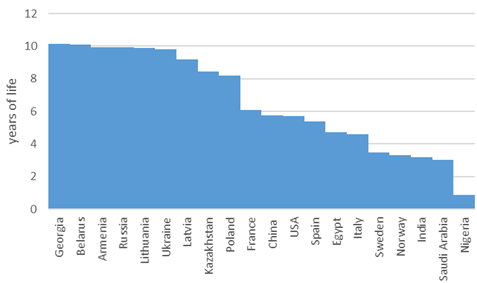
Source: World Bank.
The earliest available reliable data on the relative longevity of men and women shows that the gender gap in life expectancy is not a new phenomenon. In the middle of the 19th century, women in Scandinavian countries outlived men by 3-5 years (Rochelle et al., 2015), and Bavarian nuns enjoyed an additional 1.1 years of life, relative to the monks (Luy, 2003). At the beginning of the 20th century, relative higher female longevity became universal as women started to live longer than men in almost every country (Barford et al., 2006). GGLE appears to be a complex phenomenon with no single factor able to fully explain it. Scientists from various fields such as anthropology, evolutionary biology, genetics, medical science, and economics have made numerous attempts to study the mechanisms behind this gender disparity. Their discoveries typically fall into one of two groups: biological and behavioural. Noteworthy, GGLE seems to be fairly unrelated to the basic economic fundamentals such as GDP per capita which in turn has a strong association with the level of healthcare, overall life expectancy, and human development index (Rochelle et al., 2015). Figure B presents the (lack of) association between GDP per capita and GGLE in a cross-section of countries. The data shows large heterogeneity, especially at low-income levels, and virtually no association from middle-level GDP per capita onwards.
Figure B. Association between gender gap in life expectancy and GDP per capita
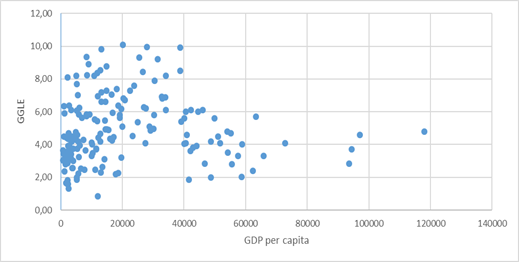
Source: World Bank.
Biological Factors
The main intuition behind female superior longevity provided by evolutionary biologists is based on the idea that the offspring’s survival rates disproportionally benefited from the presence of their mothers and grandmothers. The female hormone estrogen is known to lower the risks of cardiovascular disease. Women also have a better immune system which helps them avoid a number of life-threatening diseases, while also making them more likely to suffer from (non-fatal) autoimmune diseases (Schünemann et al., 2017). The basic genetic advantage of females comes from the mere fact of them having two X chromosomes and thus avoiding a number of diseases stemming from Y chromosome defects (Holden, 1987; Austad, 2006; Oksuzyan et al., 2008).
Despite a number of biological factors contributing to female longevity, it is well known that, on average, women have poorer health than men at the same age. This counterintuitive phenomenon is called the morbidity-mortality paradox (Kulminski et al., 2008). Figure C shows the estimated cumulative health deficits for both genders and their average life expectancies in the Canadian population, based on a study by Schünemann et al. (2017). It shows that at any age, women tend to have poorer health yet lower mortality rates than men. This paradox can be explained by two factors: women tend to suffer more from non-fatal diseases, and the onset of fatal diseases occurs later in life for women compared to men.
Figure C. Health deficits and life expectancy for Canadian men and women
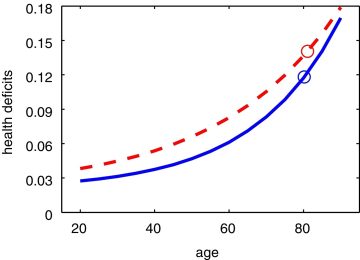
Source: Schünemann et al. (2017). Note: Men: solid line; Women: dashed line; Circles: life expectancy at age 20.
Behavioural Factors
Given the large variation in GGLE, biological factors clearly cannot be the only driving force. Worldwide, men are three times more likely to die from road traffic injuries and two times more likely to drown than women (WHO, 2002). According to the World Health Organization (WHO), the average ratio of male-to-female completed suicides among the 183 surveyed countries is 3.78 (WHO, 2024). Schünemann et al. (2017) find that differences in behaviour can explain 3.2 out of 4.6 years of GGLE observed on average in developed countries. Statistics clearly show that men engage in unhealthy behaviours such as smoking and alcohol consumption much more often than women (Rochelle et al., 2015). Men are also more likely to be obese. Alcohol consumption plays a special role among behavioural contributors to the GGLE. A study based on data from 30 European countries found that alcohol consumption accounted for 10 to 20 percent of GGLE in Western Europe and for 20 to 30 percent in Eastern Europe (McCartney et al., 2011). Another group of authors has focused their research on Central and Eastern European countries between 1965 and 2012. They have estimated that throughout that time period between 15 and 19 percent of the GGLE can be attributed to alcohol (Trias-Llimós & Janssen, 2018). On the other hand, tobacco is estimated to be responsible for up to 30 percent and 20 percent of the gender gap in mortality in Eastern Europe and the rest of Europe, respectively (McCartney et al., 2011).
Another factor potentially decreasing male longevity is participation in risk-taking activities stemming from extreme events such as wars and military activities, high-risk jobs, and seemingly unnecessary health-hazardous actions. However, to the best of our knowledge, there is no rigorous research quantifying the contribution of these factors to the reduced male longevity. It is also plausible that the relative importance of these factors varies substantially by country and historical period.
Gender inequality and social gender norms also negatively affect men. Although women suffer from depression more frequently than men (Albert, 2015; Kuehner, 2017), it is men who commit most suicides. One study finds that men with lower masculinity (measured with a range of questions on social norms and gender role orientation) are less likely to suffer from coronary heart disease (Hunt et al., 2007). Finally, evidence shows that men are less likely to utilize medical care when facing the same health conditions as women and that they are also less likely to conduct regular medical check-ups (Trias-Llimós & Janssen, 2018).
It is possible to hypothesize that behavioural factors of premature male deaths may also be seen as biological ones with, for example, risky behaviour being somehow coded in male DNA. But this hypothesis may have only very limited truth to it as we observe how male longevity and GGLE vary between countries and even within countries over relatively short periods of time.
Economic Implications
Premature male mortality decreases the total labour force of one of the world leaders in GGLE, Belarus, by at least 4 percent (author’s own calculation, based on WHO data). Similar numbers for other developed nations range from 1 to 3 percent. Premature mortality, on average, costs European countries 1.2 percent of GDP, with 70 percent of these losses attributable to male excess mortality. If male premature mortality could be avoided, Sweden would gain 0.3 percent of GDP, Poland would gain 1.7 percent of GDP, while Latvia and Lithuania – countries with the highest GGLE in the EU – would each gain around 2.3 percent of GDP (Łyszczarz, 2019). Large disparities in the expected longevity also mean that women should anticipate longer post-retirement lives. Combined with the gender employment and pay gap, this implies that either women need to devote a larger percentage of their earnings to retirement savings or retirement systems need to include provisions to secure material support for surviving spouses. Since in most of the retirement systems the value of pensions is calculated using average, not gender-specific, life expectancy, the ensuing differences may result in a perception that men are not getting their fair share from accumulated contributions.
Policy Recommendations
To successfully limit the extent of the GGLE and to effectively address its consequences, more research is needed in the area of differential gender mortality. In the medical research dimension, it is noteworthy that, historically, women have been under-represented in recruitment into clinical trials, reporting of gender-disaggregated data in research has been low, and a larger amount of research funding has been allocated to “male diseases” (Holdcroft, 2007; Mirin, 2021). At the same time, the missing link research-wise is the peculiar discrepancy between a likely better understanding of male body and health and the poorer utilization of this knowledge.
The existing literature suggests several possible interventions that may substantially reduce premature male mortality. Among the top preventable behavioural factors are smoking and excessive alcohol consumption. Many studies point out substantial country differences in the contribution of these two factors to GGLE (McCartney, 2011), which might indicate that gender differences in alcohol and nicotine abuse may be amplified by the prevailing gender roles in a given society (Wilsnack et al., 2000). Since the other key factors impairing male longevity are stress and risky behaviour, it seems that a broader societal change away from the traditional gender norms is needed. As country differences in GGLE suggest, higher male mortality is mainly driven by behaviours often influenced by societies and policies. This gives hope that higher male mortality could be reduced as we move towards greater gender equality, and give more support to risk-reducing policies.
While the fundamental biological differences contributing to the GGLE cannot be changed, special attention should be devoted to improving healthcare utilization among men and to increasingly including the effects of sex and gender in medical research on health and disease (Holdcoft, 2007; Mirin, 2021; McGregor et al., 2016, Regitz-Zagrosek & Seeland, 2012).
References
- Albert, P. R. (2015). “Why is depression more prevalent in women?“. Journal of Psychiatry & Neuroscience, 40(4), 219.
- Austad, S. N. (2006). “Why women live longer than men: sex differences in longevity“. Gender Medicine, 3(2), 79-92.
- Barford, A., Dorling, D., Smith, G. D., & Shaw, M. (2006). “Life expectancy: women now on top everywhere“. BMJ, 332, 808. doi:10.1136/bmj.332.7545.808
- Holden, C. (1987). “Why do women live longer than men?“. Science, 238(4824), 158-160.
- Hunt, K., Lewars, H., Emslie, C., & Batty, G. D. (2007). “Decreased risk of death from coronary heart disease amongst men with higher ‘femininity’ scores: A general population cohort study“. International Journal of Epidemiology, 36, 612-620.
- Kulminski, A. M., Culminskaya, I. V., Ukraintseva, S. V., Arbeev, K. G., Land, K. C., & Yashin, A. I. (2008). “Sex-specific health deterioration and mortality: The morbidity-mortality paradox over age and time“. Experimental Gerontology, 43(12), 1052-1057.
- Luy, M. (2003). “Causes of Male Excess Mortality: Insights from Cloistered Populations“. Population and Development Review, 29(4), 647-676.
- McCartney, G., Mahmood, L., Leyland, A. H., Batty, G. D., & Hunt, K. (2011). “Contribution of smoking-related and alcohol-related deaths to the gender gap in mortality: Evidence from 30 European countries“. Tobacco Control, 20, 166-168.
- McGregor, A. J., Hasnain, M., Sandberg, K., Morrison, M. F., Berlin, M., & Trott, J. (2016). “How to study the impact of sex and gender in medical research: A review of resources“. Biology of Sex Differences, 7, 61-72.
- Mirin, A. A. (2021). “Gender disparity in the funding of diseases by the US National Institutes of Health“. Journal of Women’s Health, 30(7), 956-963.
- Oksuzyan, A., Juel, K., Vaupel, J. W., & Christensen, K. (2008). “Men: good health and high mortality. Sex differences in health and aging“. Aging Clinical and Experimental Research, 20(2), 91-102.
- Regitz-Zagrosek, V., & Seeland, U. (2012). “Sex and gender differences in clinical medicine“. Sex and Gender Differences in Pharmacology, 3-22.
- Rochelle, T. R., Yeung, D. K. Y., Harris Bond, M., & Li, L. M. W. (2015). “Predictors of the gender gap in life expectancy across 54 nations“. Psychology, Health & Medicine, 20(2), 129-138. doi:10.1080/13548506.2014.936884
- Schünemann, J., Strulik, H., & Trimborn, T. (2017). “The gender gap in mortality: How much is explained by behavior?“. Journal of Health Economics, 54, 79-90.
- Trias-Llimós, S., & Janssen, F. (2018). “Alcohol and gender gaps in life expectancy in eight Central and Eastern European countries“. European Journal of Public Health, 28(4), 687-692.
- WHO. (2002). “Gender and road traffic injuries“. World Health Organization.
- WHO. (2024). “Global health estimates: Leading causes of death“. World Health Organization.
- Łyszczarz, B. (2019). “Production losses associated with premature mortality in 28 European Union countries“. Journal of Global Health.
About FROGEE Policy Briefs
FROGEE Policy Briefs is a special series aimed at providing overviews and the popularization of economic research related to gender equality issues. Debates around policies related to gender equality are often highly politicized. We believe that using arguments derived from the most up to date research-based knowledge would help us build a more fruitful discussion of policy proposals and in the end achieve better outcomes.
The aim of the briefs is to improve the understanding of research-based arguments and their implications, by covering the key theories and the most important findings in areas of special interest to the current debate. The briefs start with short general overviews of a given theme, which are followed by a presentation of country-specific contexts, specific policy challenges, implemented reforms and a discussion of other policy options.
Disclaimer: Opinions expressed in policy briefs and other publications are those of the authors; they do not necessarily reflect those of the FREE Network and its research institutes.
Russia in Africa: What the Literature Reveals and Why It Matters

Following the full-scale invasion of Ukraine in February, 2022, Russia has become increasingly isolated. In an attempt to counter Western powers’ efforts to suppress its economy and soft power impacts, Russia has tried to increase its influence in other parts of the world. In particular, Russia is increasingly active on the African continent, having become a key partner to several African regimes, typically operating in areas with weak institutions and governments. Additionally, Russia’s approach has a different focus and objectives compared to other foreign actors, which may have both short and long term consequences for the continent’s development. Deepening our understanding of Russia’s distinct approach alongside those of other global actors, as well as the future implications of their involvement on the continent is, thus, of crucial importance.
Introduction
The new Foreign Policy Concept, adopted by the Russian government in March 2023, dedicates, for the first time, a separate section to Africa. The previous versions of the policy grouped North Africa with the Middle East and contained only a single paragraph, kept unchanged over time, about Sub-Saharan Africa. In the midst of its war against Ukraine, Russia is getting serious about Africa. What do we know about the reasons for and implications of this trend?
A relatively large literature in economics, political science, international relations, and other related fields has dealt with the Soviet Union’s engagement with African regimes (see overviews in Morris, 1973 and Ramani, 2023). However, the number of studies following the evolution of these relations since the collapse of the Soviet Union is significantly smaller, reflecting Russia’s strategic withdrawal from the region between 1990 and 2015. Following the full-scale invasion of Ukraine, Russia’s increased interest in and engagement on the African continent has been increasingly discussed by security analysts and think tanks (see for instance Siegel, 2021; Stanyard, Vircoulon and Rademeyer, 2023; Jones, et al., 2021). Primarily highlighted are Russia’s interest in mineral deposits, its large-scale arms’ exports to African regimes, its dominance on the nuclear energy market with resulting dependency on Russian nuclear fuels, and its ambition to undermine Western capacities by the spread of Russian propaganda and anti-Western sentiments (Lindén, 2023). Each of these dimensions carries potentially profound and far-reaching implications for the continent’s development, as underscored by various strands of literature. Research contributions on this specific new trend are however still very limited and predominantly of a qualitative and exploratory nature.
There is, however, substantial general knowledge about the various forms that foreign interests can take, including trade, investment, development aid, propaganda, election interference, and involvement in conflicts, and their potential consequences for development. This brief presents an overview of selected literature that most closely relates to foreign influence in Africa.
Background: Theories of Foreign Policy
Two contrasting approaches are used to describe the way countries engage with the international community. The first one is the so-called realist perspective, which emphasizes the role of power, national interests, and security in shaping foreign policy (Mearsheimer, 1995). In this model, countries act in their self-interest, and often in competition or even conflict with other countries. Strategic alliances and a willingness to use force to advance one’s interests are contemplated under this perspective. The second approach is the idealist perspective, in which foreign policy is used to promote democratic values, human rights, and international cooperation, prioritizing tools such as diplomacy, international law, and multilateral institutions (Lancaster, 2008). For countries at the receiving end of major powers’ foreign policy agendas, and particularly for developing countries, the implications from the contrasting approaches will be widely different. While even a realist foreign policy may ostensibly incorporate concerns about the welfare and development of its allies, these are often not more than a thin disguise for the ultimate objective of buying political support and commercial advantages. A genuine interest in the welfare and development of receiving partners only finds a place under the idealist perspective, although even idealism is at times claimed to “greenwash” state actors’ own interests (Delmas and Burbano, 2011). While this claim has some substance to it, such accusations can also stem from the anti-western rhetoric typically pursued by Russia and aimed at undermining the credibility of actors with good intentions.
In practice, most countries’ foreign policies incorporate elements of both realism and idealism, although the balance between the two may vary. Some countries may have a predominantly realist approach, while others may prioritize idealist goals. Additionally, the same country may shift its approach over time, depending on changing circumstances and priorities. Idealism may be more prominent during periods of stability and prosperity, when countries have the resources and political will to pursue more ambitious foreign policy goals. Realism tends to become more prominent in times of crisis, when countries face serious threats to their national security or economic well-being. Historical examples of the latter are the aftermath of World War II, the Cold War, and even the 2008 global financial crisis (Roberts, 2020).
Comparative Analysis of Foreign Influence
A few studies, recent enough to encompass Russia’s renewed interest in Africa post-2015 but not enough to cover the current day resurgence, explicitly compare the strategy of different actors and their long-term influence. Trunkos (2021) develops a new soft power measure for the time-period 1995–2015, to test the commonly accepted claim in the political science literature that American soft power use has been declining while Russian and Chinese soft power use has been increasing. In the author’s own words, “the findings indicate that surprisingly the US is still using more soft power than Russia and China. The data analysis also reveals that the US is leading in economic soft power actions over China and in military soft power actions over Russia as well.”
Castaneda Dower et al. (2021) take a longer-term perspective and categorize African countries into two blocs one Western-leaning and one pro-Soviet, based on a game-theoretical model of alliances. This categorization aligns well with UN voting patterns during the Cold War, but it does not predict alignment as effectively in the post-Cold War period. The study finds no significant difference in average GDP growth between the two blocs for the period from 1990 to 2016. However, the bloc with Western-like characteristics shows higher levels of inequality and greater reliance on the market economy – as opposed to the planned one. It also has higher human capital, more gender parity (in education), and better democracy scores, but lower infrastructure capital compared to the other bloc.
Another strand of literature has looked into the deep changes that have occurred over time within the global development architecture, highlighting changes in donor and partner motivations after the end of the Cold War (Boschini and Olofsgård, 2007; Frot, Olofsgård and Perrotta Berlin, 2014), through the Arab Spring (Challand, 2014), and more recently under the emergence of new actors, chiefly China (Blair, Marty and Roessler, 2021). Studies in this area aim to highlight what implications the varying ideologies and motivation for cooperation in the donor countries have for countries at the receiving end. Competing aid regimes generate soft power through public diplomacy, often in the form of branding (for instance through putting origin “flags” on aid projects or investments). This type of positive association has been shown to generate ‘positive affect’ toward donors (Andrabi and Das, 2010), and to strengthen recipients’ perceptions of the models of governance and development that such donors promote – liberal democracy, for example, or free market capitalism (Blair, Marty and Roessler, 2021).
Emerging Players on the African Stage
An extensive literature has examined the various facets of established power actors’ presence on the continent, spanning foreign aid, diplomatic relations, and military involvement, revealing significant impacts on local economic development through multiple channels. The United States, along with other former colonial powers and major Western donors, plays a particularly prominent role in this context. Against this background, recent research has increasingly focused on the rise of new actors, and in particular China’s expanding role as a donor and investor in Africa (Bluhm, 2018; Brautigam, 2008; Brazys, Elkink and Kelly, 2017; Dreher et al. 2018). While the consensus is still unclear on whether China’s approach to aid attracts support among African citizens (Lekorwe et al. 2016; Blair, Marty, and Roessler, 2021), recent research also shows that Chinese aid exacerbates corruption and undermines collective bargaining in recipient countries (Isaksson and Kotsadam 2018a; 2018b).
As mentioned, there are as yet very few recent articles concerned with the reasons for Russia’s renewed interest in Africa (see Marten, 2019; Akinlolu and Ogunnubi, 2021; Ramani, 2023), and even fewer analyzing the potential impacts from it. One working paper, not citable due to the authors’ wishes, has quantitatively mapped and explicitly analyzed the impact of Russian military presence (in particular, of the Wagner Group) in Africa. The study found that the infamous paramilitary group faces fewer repercussions for human rights violations and commits more lethal actions than the state actors that employ them. In another recent study on the Central African Republic (CAR), Gang et al. (2023) found not only mortality levels in CAR to be four times higher than what estimated by the UN but also that Wagner mercenaries have contributed to “increased difficulties of survival” for the population in affected areas. Pardyak, M. (2022) explores the communication strategies employed by the key actors in the war, specifically focusing on how these strategies are received in African societies. Based on the analysis of over 140 media articles published in several African countries up to 15 October 2022, complemented by street surveys in Cairo, and in-depth interviews with Egyptians and Sudanese migrants, the study concludes that Russia’s multipolar perspective on the international order is more widely supported in Africa than Western strategies.
When viewed in a historical context, however, Russia’s actions reflect a longstanding adherence to a realist approach in its foreign policy endeavors. Throughout its trajectory, Russia has consistently prioritized national security and economic interests, frequently leveraging military and economic means to safeguard these interests (Tsygankov and Tsygankov, 2010). Presently, amid mounting pressures from the Western democratic world following the full-scale invasion of Ukraine in February 2022, Russia finds itself increasingly reliant on a realist approach. While the Chinese engagement in Africa is also characterized by realist principles, it’s important to emphasize that the Russian approach diverges from that of China. China is focused on a long-term presence, infrastructure building and investments. It has no interest in democracy and human rights, is efficient and cheap though not always loved (Isaksson and Kotsadam, 2018b). Russia’s interest is more short term and opportunistic, seeking out countries rich in natural resources with unstable governments and weak institutions, such as Libya, Sudan, Mozambique, the Central African Republic, Mali, Burkina Faso and Madagascar. Russia typically targets undemocratic elites or military juntas, offering political support, military equipment sales, and security cooperation (in particular through the Wagner Group) in exchange for access to natural resources, concession rights and influence. State of the art research on a previous period (Berman et al., 2017, spanning 1997 to 2010), although not exclusively focused on Russia, finds that rents from mineral contracts, captured by swings in global mineral prices for a causal interpretation, lead to a higher likelihood of local conflicts, and furthermore that the control of mining areas by rebel groups can escalate violence beyond the local level.
Russia is pursuing a range of strategic goals that include diplomatic legitimization, media influence, military presence, elite influence, arms export, and shaping voting patterns in international organizations (Lindén, 2023). Like China, Russia is uninterested in democracy or human rights. Moreover, what Russia stands for is in stark contrast to the Western model. Russia embodies autocracy and backward revisionist values (for instance in areas such as attitudes to gender equality and the sustainability agenda) while the West generally promotes democracy and progressive inclusive solutions (Lindén, 2023). What also especially characterizes Russia is the particular attraction towards the presence of anti-West sentiment, which it fuels through populistic anti-colonial disinformation and propaganda. This approach has been criticized for potentially weakening democratic norms and sidelining African agency (Akinlolu and Ogunnubi, 2021). Additionally, Russia’s disregard for the socio-political realities in Africa, typically associated with a self-interested realist approach, can lead to ineffective engagement and unintended negative consequences, undermining the long-term sustainability of both social and economic developments in the region.
Conclusion
Many African countries find themselves in a delicate balancing act, as they cannot afford to push away Russia nor displease their historical Western partners. This attempt to balance between actors poses several risks and potentially detrimental consequences, including reduced development cooperation, slower democratization, limited progress on human rights, and increased conflicts. Additionally, Russia’s growing presence in Africa can have implications for the interests and policies of the European Union (EU) and its member states as well as global actors, including impacts on migration, terrorism, the energy sector as well as on trade and aid flows.
In light of the diverse strategies foreign powers use in their relations with African countries and the significant impact these strategies have, it is crucial to deepen our understanding of foreign engagements in Africa. By examining Russia’s distinct approach alongside those of other global actors, we can gain valuable insights into the complex dynamics shaping the continent’s political, economic, and social landscape, both now and in the future. Expanding research in this area is not only desirable but essential for informing policy and development strategies.
References
- Akinlolu E. A. and Ogunnubi, O. (2021). Russo-African Relations and electoral democracy: Assessing the implications of Russia’s renewed interest for Africa, African Security Review, 30:3, 386-402, DOI: 10.1080/10246029.2021.1956982
- Andrabi, T., & Das, J. (2010). In Aid We Trust: Hearts and Minds and the Pakistan Earthquake of 2005. World Bank Policy Research Working Paper, (5440).
- Berman, N., Couttenier, M., Rohner, D., & Thoenig, M. (2017). This Mine is Mine! How Minerals Fuel Conflicts in Africa. American Economic Review, 107(6), 1564-1610.
- Challand, B. (2014). Revisiting Aid in the Arab Middle East. Mediterranean Politics, 19(3), 281-298. DOI: 10.1080/13629395.2014.966983
- Blair, R. A., Marty, R., and Roessler, P. (2021). Foreign Aid and Soft Power: Great Power Competition in Africa in the Early Twenty-first Century. British Journal of Political Science, 52(3), 1355–1376. doi:10.1017/S0007123421000193
- Bluhm, R., et al. (2018). Connective Financing: Chinese Infrastructure Projects and the Diffusion of Economic Activity in Developing Countries. AidData Working Paper 64.
- Boschini, A., and Olofsgård, A. (2007). Foreign aid: An instrument for fighting communism? The Journal of Development Studies, 43(4), 622-648. DOI: 10.1080/00220380701259707
- Brautigam, D. (2009). The Dragon’s Gift: The Real Story of China in Africa. Oxford: Oxford University Press.
- Castaneda Dower, P., Gokmen, G., Le Breton, M., & Weber, S. (2021). Did the Cold War Produce Development Clusters in Africa? (Working Papers; No. 2021:10).
- Delmas, M. A. and Burbano, V. C. (2011). The Drivers of Greenwashing. California Management Review, 54(1), 64-87.
- Dreher, A., et al. (2018). Apples and dragon fruits: The determinants of aid and other forms of state financing from China to Africa. International Studies Quarterly, 62(1), 182–194.
- Frot, E., Olofsgård, A., and Perrotta Berlin, M. (2014). Aid Effectiveness in Times of Political Change: Lessons from the Post-Communist Transition. World Development, 56, 127-138. https://doi.org/10.1016/j.worlddev.2013.10.016
- Isaksson, A-S., and Kotsadam, A. (2018a). Chinese aid and local corruption. Journal of Public Economics, 159, 146–159.
- Isaksson, A-S., and Kotsadam, A. (2018b). Racing to the bottom? Chinese development projects and trade union involvement in Africa. World Development, 106, 284–298.
- Jones, S. G., Doxsee, C., Katz, B., McQueen, E. and Moye, J. (2021). Russia’s Corporate Soldiers. The Global Expansion of Russia’s Private Military Companies. A Report of the CSIS Transnational Threats Project. CSIS. https://csis-website-prod.s3.amazonaws.com/s3fs-public/publication/210721_Jones_Russia%27s_Corporate_Soldiers.pdf?VersionId=7fy3TGV3HqDtRKoe8vDq2J2GGVz7N586
- Gang, K. B. A., O’Keeffe, J., Anonymous et al. (2023). Cross-sectional survey in Central African Republic finds mortality 4-times higher than UN statistics: how can we not know the Central African Republic is in such an acute humanitarian crisis?. Conflict and Health, 17(21). https://doi.org/10.1186/s13031-023-00514-z
- Lancaster, C. (2008). Foreign aid: Diplomacy, development, domestic politics. University of Chicago Press.
- Lekorwe, M., et al. (2016). China’s growing presence in Africa wins largely positive popular reviews. Afrobarometer Dispatch, 122.
- Lindén, K. (2023). Russia’s relations with Africa: Small, military-oriented and with destabilising effects. FOI Memo 8090. https://www.foi.se/rapportsammanfattning?reportNo=FOI%20Memo%208090
- Marten, K. (2019). Russia’s use of semi-state security forces: the case of the Wagner Group, Post-Soviet Affairs, 35:3, 181-204, DOI: 10.1080/1060586X.2019.1591142
- Mearsheimer, J. (1995). A Realist Reply. International Security, 20(1), 82-93. https://doi.org/10.2307/2539218
- Morris, M. D. (1973). The Soviet Africa Institute and the development of African studies. The Journal of Modern African Studies, 11(2), 247-265.
- Olofsgård, A., Perrotta Berlin, M. and Bonnier, E. (2023). Foreign Aid and Female Empowerment. SITE Working Paper Series, No. 62.
- Pardyak, M. (2022). Fighting for Africans’ Hearts and Minds in the Context of the 2022 War in Ukraine. Journal of Central and Eastern European African Studies, 2(4), 158-194.
- Ramani, Samuel, Russia in Africa: Resurgent Great Power or Bellicose Pretender? (2023; online edn, Oxford Academic, 28 Sept. 2023), https://doi.org/10.1093/oso/9780197744598.001.0001
- Roberts, A. (2020). “Whatever It Takes”: Danger, Necessity, and Realism in American Public Policy. Administration & Society, 52(7), pp. 1131-1144. https://doi.org/10.1177/0095399720938550
- Siegel, J. (2021). Herd, P. G. (ed). Russia’s Global Reach: A Security and Statecraft Assessment. Garmisch-Partenkirchen: George C. Marshall European Center for Security Studies. https://www.marshallcenter.org/en/publications/marshall-center-books/russias-global-reach-security-and-statecraft-assessment
- Stanyard, J., Vircoulon, T. and Rademeyer, J. (2023). The grey zone: Russia’s military, mercenary and criminal engagement in Africa. The Global Intitaive against transnational organized crime. https://globalinitiative.net/wp-content/uploads/2023/02/Julia-Stanyard-T-Vircoulon-J-Rademeyer-The-grey-zone-Russias-military-mercenary-and-criminal-engagement-in-Africa-GI-TOC-February-2023-v3-1.pdf
- Trunkos, J. (2021) Comparing Russian, Chinese and American Soft Power Use: A New Approach, Global Society, 35:3, 395-418, DOI: 10.1080/13600826.2020.1848809
- Tsygankov, A. P., & Tsygankov, P. A. (2010). Russian theory of international relations. In Oxford Research Encyclopedia of International Studies.
Disclaimer: Opinions expressed in policy briefs and other publications are those of the authors; they do not necessarily reflect those of the FREE Network and its research institutes.
Why the National Bank of Georgia Is Ditching Dollars for Gold

The National Bank of Georgia (NBG) recently acquired 7 tons of high-quality monetary gold valued at $500 million, constituting approximately 11 percent of the banks’ total reserves. This marked the first occasion that Georgia acquired gold for its reserves since regaining its independence. The acquisition is a significant event, prompted by the NBG’s stated aim to enhance diversification amidst increased global geopolitical risks. However, diversification is just one of the reasons many countries are extensively purchasing gold. Another reason for increasing gold reserves is to lessen one’s reliance on the US dollar and to protect against sanctions, as seen with Russia and Belarus following the annexation of Crimea. While the NBG’s gold acquisition aligns with economic rationale, recent domestic developments suggest other motives. Actions like sanctions on political figures, anti-Western rhetoric, and recent legislation (the Law of Transparency of Foreign Influence), diverging Georgia from an EU pathway call for speculation that the gold purchase is driven by fear a of potential sanctions and as a preparedness strategy.
Introduction
The National Bank of Georgia (NBG) has broken new ground by adding gold to the country’s international reserves for the first time ever. Georgia has thus become the first country in the South Caucasus to purchase gold for its reserves. In line with its Board’s decision on March 1, 2024, the NBG procured 7 tons of the highest quality (999.9) monetary gold. The acquisition, valued at 500 million US dollars, took the form of internationally standardized gold bars, purchased from the London gold bar market and currently stored in London. Presently, the acquired gold represents approximately 11 percent of the NBG’s international reserves (see Figure 1).
Figure 1. NBG’s Official Reserve Assets and Other Foreign Currency Assets, 2023-2024.
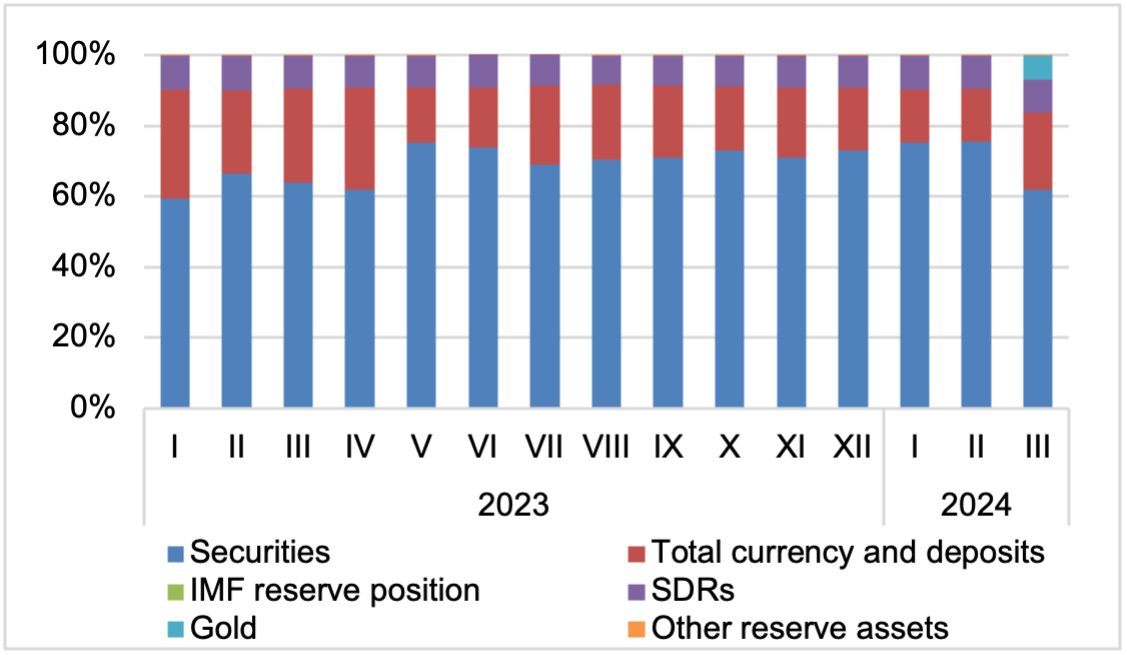
Source: The National Bank of Georgia.
The NBG emphasizes in its official statement that the acquisition of gold is not merely symbolic but rather reflects a deliberate strategy of diversifying NBG’s portfolio and enhancing its resilience to external shocks. The NBG’s decision was made during a period marked by significant economic and political events both within and outside Georgia. Key among these were global and regional geopolitical tensions that amplified concerns about economic downturns and rising inflation. The Covid-19 pandemic in 2020 led to stagflation across many countries, including Georgia. Despite some recovery in GDP, high inflation continued into 2021. Furthermore, the Russian war on Ukraine disrupted supply chains, and pushed global inflation to a 24-year high 8.7 percent in 2022. In response, stringent monetary policies aimed at controlling inflation were implemented across both developing and advanced economies. Looking ahead, there is an expectation of a shift toward more expansionary monetary policies that should help lower interest rates (and lower yields on assets held by central banks). These global conditions provide context for the NBG’s strategic focus on diversification.
However, alongside these economic events, Georgia also faces significant political challenges. Since the beginning of Russia’s war in Ukraine in 2022, political tensions in Georgia have escalated. Notable actions such as the U.S. imposing sanctions on influential Georgian figures, including judges and the former chief prosecutor, have, among other things, intensified scrutiny into the Russian influence in Georgia. Concerns about the independence of the Central Bank, which changed the rule of handling sanctions applications for Georgia’s citizens, and legislative initiatives like the Law of Transparency of Foreign Influence, which undermines Georgia’s EU accession ambitions, have triggered reactions from the country’s partners and massive public protests. Moreover, anti-Western rhetoric from the ruling party has raised concerns. In addition, the parliament of Georgia recently approved an amendment to the Tax Cide, a so-called ‘law on offshores’. The opaque nature of the law, as well as the context and speed at which it was advanced, sparked outcry and conjecture about its true purpose. These elements lead to speculation that the decision to purchase gold may be motivated by a desire for greater autonomy or a fear of potential sanctions, rather than purely economic reasons.
In the context of the above, this policy brief seeks to explore the motivations behind gold acquisitions by Central Banks, drawing on the experiences of both developed and developing countries. It aims to review existing literature that explores various reasons for gold acquisitions, providing a comprehensive analysis of economic and potentially non-economic factors influencing such decisions.
The Return of Gold in Global Finance
Over the past decade, central bank gold reserves have significantly increased, reversing a 40-year trend of decline. The shift that began around the time of the 2008-09 Global Financial Crisis is depicted in Figures 2 and 3, highlighting the transition from a pre-crisis period of more countries selling gold, to a post-crisis period where more countries have been purchasing gold.
Figure 2. Gold Holdings in Official Reserve Assets, 1999-2022 (million fine Troy ounces).

Source: IMF, International Financial Statistics.
Figure 3. Number of Countries Purchasing/Selling Monetary Gold, 2000-2021 (at least 1 metric ton of gold in a given year).
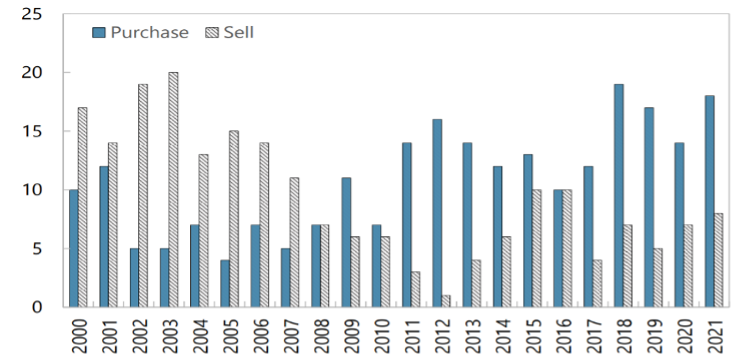
Source: IMF, International Financial Statistics.
In 2023, central banks added a considerable amount of gold to their reserves. The largest purchases have been reported for China, Poland, and Singapore, with these nations collectively dominating the gold buying landscape during the year.
China is one of the top buyers of gold worldwide. In 2023, the People’s Bank of China emerged as the top gold purchaser globally, adding a record 225 tonnes to its reserves, the highest yearly increase since at least 1977, bringing its total gold reserves to 2,235 tonnes. Despite this significant addition, gold still represents only 4 percent of China’s extensive international reserves.
The National Bank of Poland was another significant buyer in 2023, acquiring 130 tonnes of gold, which boosted its reserves by 57 percent to 359 tonnes, surpassing its initial target and reaching the bank’s highest recorded annual level.
Other central banks, including the Monetary Authority of Singapore, the Central Bank of Libya, and the Czech National Bank, also increased their gold holdings, albeit on a smaller scale. These purchases reflect a broader trend of central banks diversifying their reserves and enhancing financial security amidst global economic uncertainties.
Conversely, the National Bank of Kazakhstan and the Central Bank of Uzbekistan were notable sellers, actively managing their substantial gold reserves in response to domestic production and market conditions. The Central Bank of Bolivia and the Central Bank of Turkey also reduced their gold holdings, primarily to address domestic financial needs.
The U.S. continues to hold the world’s largest gold reserve (25.4 percent of total gold reserves), which underscores the metal’s enduring appeal as a store of value among the world’s leading economies. The U.S. is followed by Germany at 10.5 percent, and Italy and France at 7.6 percent respectively. At present, around one-eighth of the world’s currency reserves comprise of gold, with central banks collectively holding 20 percent of the global gold supply (NBG, 2024).
Why Central Banks are Buying Gold Again
A 2023 World Gold Council survey (on central banks revealed five key motivations for holding gold reserves: (1) historical precedent (77 percent of respondents), (2) crisis resilience (74 percent), (3) long-term value preservation (74 percent), (4) portfolio diversification (70 percent), and (5) sovereign risk mitigation (68 percent). Notably, emerging markets placed a higher emphasis (61 percent) on gold as a “geopolitical diversifier“ compared to developed economies (45 percent).
However, the increasing use of the SWIFT system for sanctions enforcement (e.g., Iran in 2015 and Russia in 2022) has introduced a new factor influencing gold purchases of some governments: safeguarding against sanctions (Arslanalp, Eichengreen and Simpson-Bell, 2023).
In addition, Arslanalp, Eichengreen, and Simpson-Bell (2023) conclude that central banks’ decisions to acquire gold are primarily driven by the following factors; inflation, the use of floating exchange rates, a nation’s fiscal stability, the threat of sanctions, and the degree of trade openness (see Figure 4).
Figure 4. Determinants of Gold Shares in Emerging Market and Developing Economies.
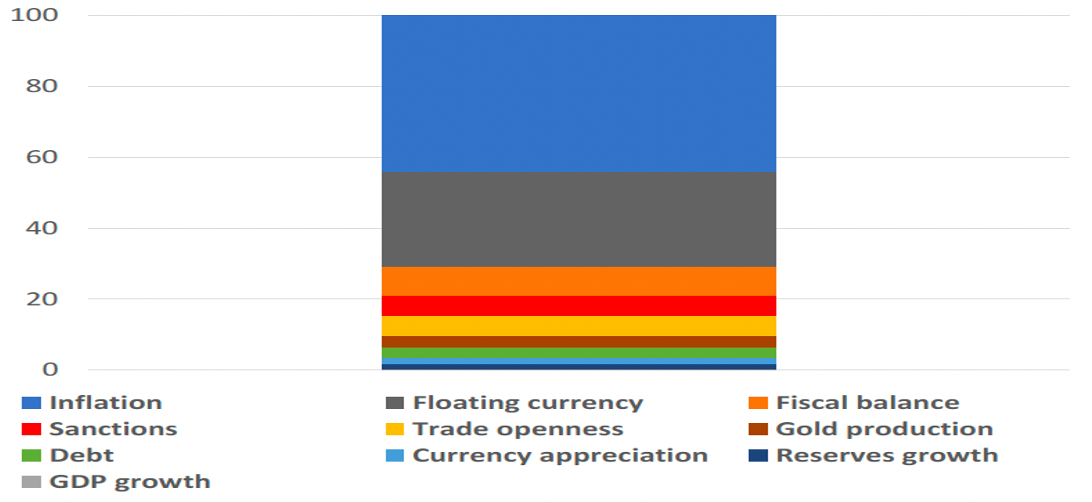
Source: Arslanalp, Eichengreen, and Simpson-Bell (2023).
Gold as a Hedging Instrument
Gold is considered a safe haven and an attractive asset in periods of significant economic, financial, and geopolitical uncertainty (Beckman, Berger, & Czudaj, 2019). This is particularly relevant when returns on reserve currencies are low, a scenario prevalent in recent years.
A hedge against inflation: Inflation presents a significant challenge for central banks, as it erodes the purchasing power of a nation’s currency. Gold has been a long-standing consideration for central banks as a potential inflation hedge. Its price often exhibits an inverse relationship with the value of the US dollar, meaning it tends to appreciate as the dollar depreciates. This phenomenon can be attributed to two primary factors: (1) increased demand during inflationary periods; and (2) gold tends to have intrinsic value unlike currencies (Stonex Bullion, 2024).
Diversification of portfolio: Diversification is a cornerstone principle of portfolio management. It involves allocating investments across various asset classes to mitigate risk. Gold, with its negative correlation to traditional assets like stocks and bonds, can be a valuable tool for portfolio diversification. In simpler terms, when stock prices decline, gold prices often move in the opposite direction, offering a potential hedge against market downturns (see Figure 5).
Figure 5. How Gold Performs During Recession, 1970-2022.
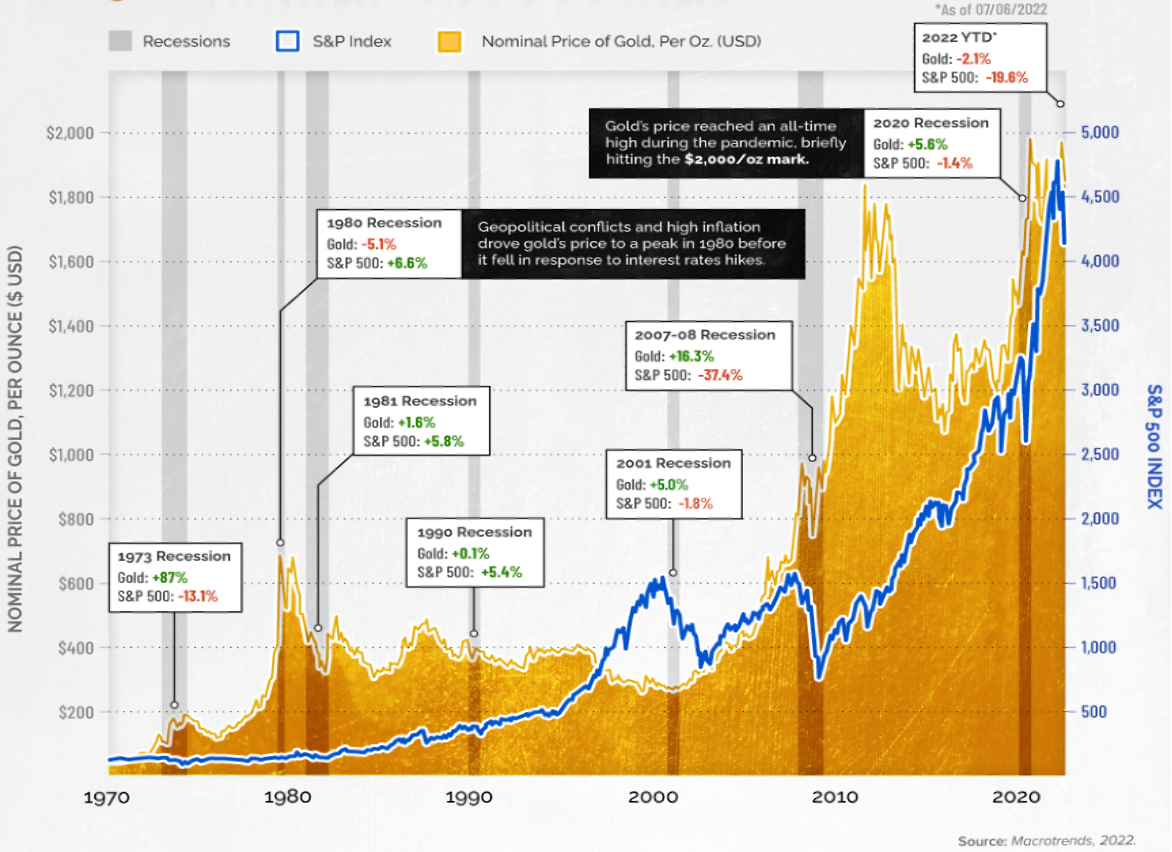
Source: Bhutada (2022).
Hedge against geopolitical risks: de Besten, Di Casola and Habib (2023) suggest that geopolitical factors may have influenced gold acquisitions for some central banks in 2022. A positive correlation appears to exist between changes in a country’s gold reserves and its geopolitical proximity to China and Russia (compared to the U.S.) for countries actively acquiring gold reserves. This pattern is particularly evident in Belarus and some Central Asian economies, suggesting they may have increased their gold holdings based on geopolitical considerations.
Low or Negative Interest Rates: When interest rates on major reserve currencies like the US dollar are low or negative, it reduces the opportunity cost of holding gold (gold is a passive asset that does not generate periodic income, dividends, and interest benefits). In other words, gold becomes a more attractive option compared to traditional investments that offer minimal or no returns. The prevailing low-interest rate environment, particularly for major reserve currencies like the US dollar, has diminished the opportunity cost of holding gold.
This phenomenon applies to both advanced economies and emerging market economies (EMDEs). Notably, EMDEs with significant dollar-denominated debt are particularly sensitive to fluctuations in US interest rates. Arslanalp, Eichengreen, and Simpson-Bell (2023) conclude that reserve managers are increasingly incorporating gold into their portfolios when returns on reserve currencies are low. Figure 6 illustrates the inverse relationship between the price of gold and the inflation-adjusted 10-year yield.
Figure 6. Gold Price and Inflation-Adjusted 10-Year Yield.
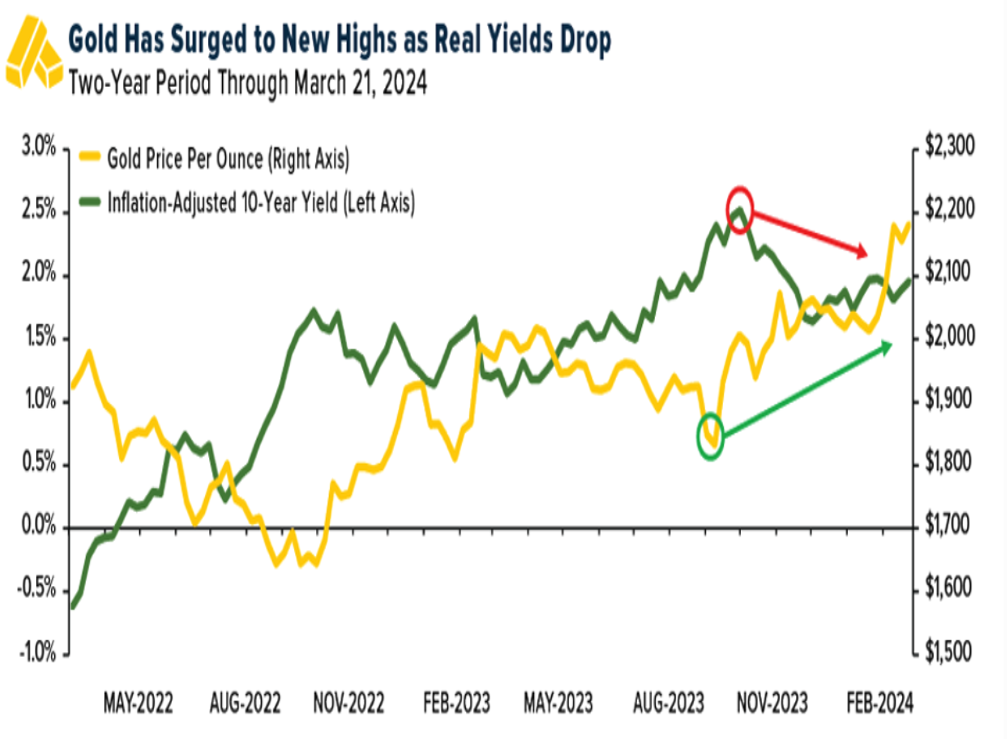
Source: Bloomberg, U.S. Global Investors.
In addition to its aforementioned advantages, gold offers central banks a long-term investment opportunity despite its lack of interest payments, unlike traditional securities. While gold exhibits short-term price volatility, its historical price trend suggests a long-term upward trajectory (see Figure 7).
Figure 7. Gold Price per Troy Ounce (approximately 31.1 grams), in USD.
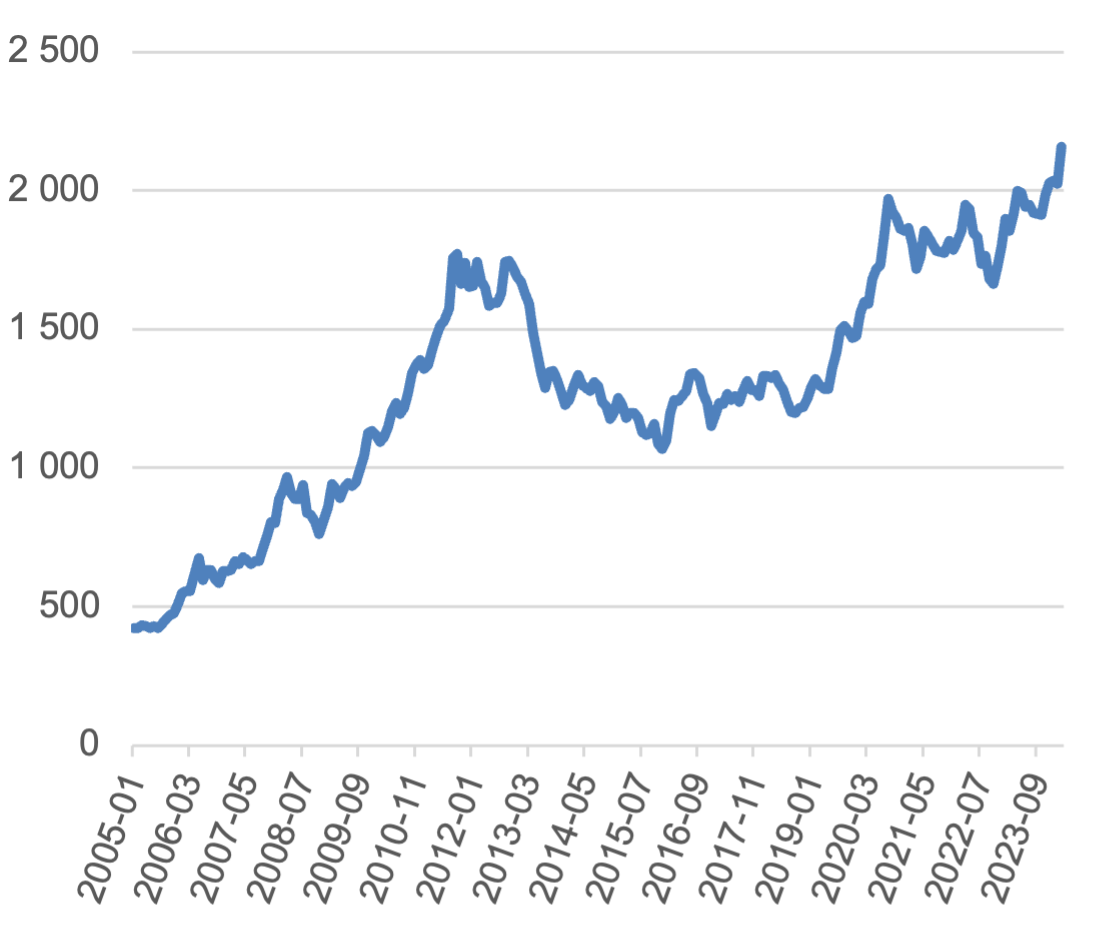
Source: World Gold Council.
Gold as a Safeguard Against Sanctions
Gold is perceived as a secure and desirable reserve asset in situations where countries face financial sanctions or the risk of asset freezes and seizures (see Table 1). The decision by G7 countries to freeze the foreign exchange reserves of the Bank of Russia in 2022 highlighted the importance of holding reserves in a form less vulnerable to sanctions. Following Russia’s annexation of Crimea in 2014, the Bank of Russia intensified its gold purchases. By 2021, it had confirmed that its gold reserves were fully vaulted domestically. The imposition of sanctions on Russia, which restrict banks from engaging in most transactions with Russian counterparts and limit the Bank of Russia’s access to international financial markets, further underscores the appeal of gold as a safeguard.
While the recent sanctions imposed by G7 countries, which limit Russian banks from conducting most business with their counterparts and restrict the Bank of Russia from accessing its reserves in foreign banks, are an extreme example, similar sanctions have previously impacted or threatened financial operations of other nations’ central banks and governments. This situation raises the question of whether the risk of sanctions has influenced the observed trend of countries’ increasing their gold reserves (IMF, International Financial Statistics, 2022).
Table 1. Top 10 Annual Increases in the Share of Gold in Reserves, 2000-2021.
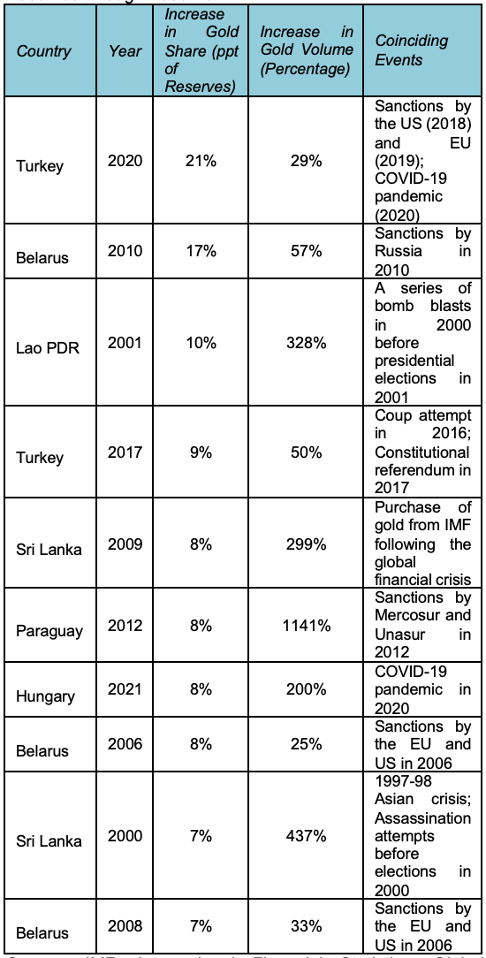
Source: IMF, International Financial Statistics; Global Sanctions Database (GSDB). Note: Excludes countries with central bank gold purchases from domestic producers.
As outlined in Arslanalp, Eichengreen and Simpson-Bell (2023), there were eight active diversifiers into gold in 2021, each purchasing at least 1 million troy ounces (Kazakhstan, Belarus, Turkey, Uzbekistan, Hungary, Iraq, Argentina, Qatar), exhibiting distinct international economic or political concerns. Kazakhstan, Belarus, and Uzbekistan maintain ties with Russia through the Eurasian Economic Union. Turkey has faced sanctions from both the European Union and the U.S. Iraq has experienced disputes with the U.S., while Hungary has faced similar issues with the European Union. In 2017-21, Qatar was subjected to a travel and economic embargo by Saudi Arabia and neighboring countries. Argentina may have had concerns about asset seizures by foreign courts due to sovereign debt disputes.
Furthermore, according to the Economist (2022), gold is costly to transport, store, and protect. It is expensive to use in transactions and doesn’t earn interest. However, it can be lent out like currencies in a central bank’s reserves. When lent out or used in swaps (where gold is exchanged for currency at agreed dates), it can generate returns. But banks prefer gold to be stored in specific places like the Bank of England or the Federal Reserve Bank of New York, which brings back the risk of sanctions. For instance, During the Iranian Revolution in 1979 and the subsequent hostage crisis, the United States froze Iranian assets, including the gold reserves held in U.S. banks (Arslanalp, Eichengreen and Simpson-Bell, 2023). The National Bank of Georgia intends to transport its acquired gold from England to Georgia for storage, which could potentially reduce storage costs, but further decrease liquidity.
Arslanalp, Eichengreen, and Simpson-Bell (2023) conclude that since the early 2000s, half of the significant year-over-year increases in central bank gold reserves can be attributed to the threat of sanctions. By examining an indicator that tracks financial sanctions by major economies like the United States, United Kingdom, European Union, and Japan, all key issuers of reserve currencies, the authors have confirmed a positive correlation between such sanctions and the proportion of reserves held in gold. Furthermore, their findings suggest that multilateral sanctions imposed by these countries collectively have a more pronounced effect on increasing gold reserves than unilateral sanctions. This is likely because unilateral sanctions allow room for shifting reserves into the currencies of other non-sanctioning nations, whereas multilateral sanctions increase the risks associated with holding foreign exchange reserves, thus making gold a more attractive option.
The NBG’s Historic Decision
The National Bank of Georgia’s (NBG) recent acquisition of gold for its reserves is likely motivated by a desire to diversify its portfolio and hedge against inflation and geopolitical risks. However, recent developments in Georgia raise questions about the timing of this policy decision, bringing political considerations into the picture.
Among these developments is the 2023 suspension of the IMF program for Georgia, due to concerns about the NBG’s governance (Intellinews, 2023). The amendments to the NBG law in June 2023, which created a new First Deputy and Acting Governor position – superseding the existing succession framework – contradicted IMF Safeguards recommendations and raised concerns about increased political influence (International Monetary Fund, 2024). How the recent gold purchase reflect on the future of IMF cooperation is thus a relevant question to ask.
Another ground for concern is the recent approval by the Georgian Parliament of the anti-democratic “Foreign Influence Transparency” law and the anti-Western rhetoric of the ruling party, which have sparked intensive public protests. European partners warn that the law will not align with Georgia’s European Union aspirations and that it could potentially hinder the country’s advancement on the EU pathway. Rather, the law might distance Georgia from the EU. This law has also increased the concerns for further sanctions on members of the ruling party, government officials, and individuals engaging in anti-West and anti-EU propaganda.
Furthermore, the recent amendment of the Tax Code, the so-called “offshores law” allows for tax-free funds transfers from offshore zones to Georgia. This, combined with other developments, raises questions about whether the government is preparing for potential sanctions, should its relationship with Russia continue to strengthen.
Conclusion
In conclusion, this policy brief highlights that central banks’ acquisition of gold reserves, especially in emerging economies, is motivated by a combination of economic and political factors. The economic incentives include the need for portfolio diversification and protection against inflation and geopolitical instabilities, a trend that became more pronounced following the 2008 global financial crisis. Politically, the accumulation of gold serves as a strategic move to lessen dependency on the U.S. dollar and as a defensive measure against potential international sanctions, as highlighted by the post-2014 geopolitical shifts following Russia’s annexation of Crimea.
In 2024, Georgia purchased gold for the first time since regaining its independence. While its gold purchasing strategy seems to align with these economic motives, the recent domestic political dynamics suggest a deeper, possibly strategic political rationale by the National Bank of Georgia. The imposition of U.S. sanctions on key figures, and recent legislative actions deviating from European Union standards, all amidst increasing anti-Western sentiment, indicate that the NBG’s gold acquisitions might also be driven by a quest for greater safeguard against potential future sanctions. Thus, while economic reasons for the purchase are significant, the political underpinnings in the NBG’s recent actions raise numerous unanswered questions.
References
- Arslanalp, S., Eichengreen, B., & Simpson-Bell, C. (2023). Gold as International Reserves: A Barbarous Relic No More? IMF Working Papers.
- Beckman, J., Berger, T., & Czudaj, R. (2019). Gold Price Dynamics and the Role of Uncertainty. Quantitative Finance , 663-681.
- Bhutada G. (2022). Does Gold’s Value Increase During Recessions? Elements Visualcapitalist.
- de Besten, T., Di Casola, P., & Habib M. M. (2023). Geopolitical fragmentation risks and international currencies. The international role of the euro.
- The Economist. (2022). Why gold has lost some of its investment allure. https://www.economist.com/finance-and-economics/2022/01/08/why-gold-has-lost-some-of-its-investment-allure
- International Monetary Fund (2024). Georgia: 2024 Article IV Consultation-Press Release; Staff Report; and Statement by the Executive Director for Georgia. IMF Country Reports 24/135
- Intellinews. (2023). https://www.intellinews.com/georgia-s-national-bank-president-confirms-suspension-of-imf-programme-294545/
- StoneX Bullion (2024). Why Central Banks Buy Gold.
Disclaimer: Opinions expressed in policy briefs and other publications are those of the authors; they do not necessarily reflect those of the FREE Network and its research institutes.
Stockholm Institute of Transition Economics Celebrates Its 35th Anniversary

June 15, 2024, marks a significant milestone for the Stockholm Institute of Transition Economics (SITE) as it celebrates its 35th anniversary. Over the past three and a half decades, SITE has established itself as a leading institution dedicated to economic research and the development of policies for transition economies.
From its beginnings as Östekonomiska Institutet in 1989, under the leadership of Anders Åslund, to the rebranding as SITE in 1996 with Erik Berglöf at the helm, SITE has continuously evolved as a research institution, securing a position among the world’s top think tanks in the field of economics, with a focus on Eastern Europe. In 2006, Torbjörn Becker brought his expertise from the International Monetary Fund (IMF) to lead SITE into a new era of research excellence, strengthening the focus on institution-building in the region.
Reflecting on this anniversary, Torbjörn Becker, Director of SITE, says:
“As we celebrate 35 years of economic research, policy analysis, and institution building, we are reminded of how important it is that we continue to work in this region. I am particularly proud that we are able to work with our fantastic partners in the FREE Network that make significant contributions to how their respective countries reform and develop.”
Building Institutions for Change
Since its foundation in 1989, SITE has been at the forefront of economic research and policy development in transition economies, playing a crucial role in establishing independent think tanks and academic institutions in Belarus, Georgia, Latvia, Poland, Russia, and Ukraine. These research institutes collectively established the Forum for Research on Eastern Europe and Emerging Economies (FREE Network); an umbrella organization that fosters collaboration and mutual learning among researchers, as well as administrative and institutional capacity building. As one of its key initiatives, the network publishes weekly policy briefs addressing contemporary economic policy challenges in Eastern Europe and emerging markets.
Bridging the Gap Between Research and Policy Making
SITE’s ambition for the years to come remains unchanged: to bridge the gap between leading academic research and current policy making through debate and communication. At our flagship events, such as SITE Development Day and the SITE Academic Conference, we are committed to debating topics where research can pave the way to solving global and regional challenges. In our weekly seminars and regular workshops, we remain dedicated to exchanging ideas with leading experts and policymakers. In the last decades, SITE’s research has been cited by top journals in economics, while its impact beyond academic journals has resulted in more than 30 million impressions across local and international news.
Key Milestones in SITE’s History
Succession Dynamics in Latvian Family Firms

This policy brief examines the emergence, succession, and performance of first-generation family firms in Latvia, highlighting the unique challenges and achievements of these businesses since the early 1990s. Following Latvia’s independence, many family firms were established, providing a natural setting to study succession issues. Key findings reveal that initially, nearly half of these firms did not have a majority stake held by the founding family, but within the first few years after founding, families accumulated majority ownership. It typically took seven years for family ownership to exceed 75 percent. However, 23 years later, only 16 percent of the sample firms have second-generation shareholders. Notably, around 80 percent of these firms remain majority-owned and managed by their founders. Furthermore, family firms outperform non-family firms by 3.1 percent in return on assets (ROA). The findings underscore the need for policies that support effective succession planning, incentivize family-owned business sustainability, and provide targeted training for future generations to maintain the robust economic contributions of these firms.
Introduction
Family firms, where key decisions are controlled by individuals linked by blood or marriage, are the predominant organizational form worldwide. These firms face critical challenges, (e.g. leadership transition, generational differences, emotional ties to the business, and estate planning tax considerations) particularly during ownership succession, which is the transition from the first to the second generation of family members. This issue is especially relevant in Eastern European countries like Latvia, where the shift from a planned to a market economy in the 1990s created the first generation of family firms now approaching generational change.
Understanding how family firms manage this transition is crucial for policymakers, business leaders, and researchers. This policy brief highlights the key findings of a study (Pajuste and Berzins (2024) on Latvian family firms, focusing on ownership succession patterns, the involvement of the next generation, and the impact on firm performance.
Succession Patterns and Ownership Evolution
In Latvia, many family firms began with founders holding minority stakes, reflecting financial constraints and economic uncertainties. Over time, families gradually increased their ownership stakes, demonstrating resilience and strategic planning. On average, it took seven years for family ownership to exceed 75 percent. This gradual ownership increase helped families navigate the challenges of economic transitions and limited access to external capital. The study also reveals that 23 years after being founded, only 16 percent of the sample firms have second-generation family members as shareholders.
Involvement of the Second Generation
The emergence of the second generation in family firm ownership is a pivotal phase. Succession planning and the transmission of familial values, knowledge, and entrepreneurial ethos are crucial during this period. By 2022, only 14 percent of the sample family firms had significant second-generation involvement (defined as the second generation holding a majority of the family shares and having a board seat).
More specifically, in a sample of 266 family firms, 20 percent had involved the second generation in ownership by 2022, with significant involvement in 71 percent of these cases. At the same time, 80 percent of the firms were still majority-owned and managed by the founders. This slow involvement of the second generation highlights the challenges of succession planning and the need for a strategic approach – both from a company and a legal perspective – to ensure a smooth transition from the first to second generation.
Importantly, despite this slow transition, family firms tend to perform better than non-family firms, with a 3.1 percent higher return on assets (ROA). However, within family firms, the involvement of the second generation does not significantly impact firm performance.
Policy Implications and Recommendations
The findings of this study have several important implications for policymakers, business leaders, and researchers.
Support for Succession Planning
There is a need for policies and programs that support succession planning in family firms. This includes providing resources and guidance for families to develop succession plans, ensuring the continuity of family businesses. Ensuring some form of succession, whether within the family or through external parties, is crucial to prevent these firms from closing. Facilitating succession and supporting the survival of these firms would not only protect jobs, but also have a positive economic effect as family firms outperform their non-family counterparts.
Financial Support and Access to Capital
Another way to enable smoother transition and growth for family firms is to improve their access to capital to help them overcome financial constraints. Financial institutions and government programs should focus on providing tailored financial products for family businesses. By doing so, they not only support the longevity of these businesses but also help in maintaining employment levels and preventing the economic fallout from family firm closures.
Education and Training
Educational programs and training for the next generation of family business leaders are essential. These programs should focus on leadership, management, and the unique challenges of family businesses, preparing the next generation for successful transitions.
Awareness and Best Practices
Raising awareness about the importance of succession planning and sharing best practices can help family firms navigate generational transitions more effectively.
Research and Data Collection
Continued research and data collection on family firms and their succession patterns are crucial. This helps in understanding the challenges and opportunities faced by family businesses, informing policies and practices that support their continuation and success.
Conclusion
Latvian family firms, like their counterparts worldwide, face significant challenges during ownership succession. This study highlights the gradual and strategic increase in family ownership stakes, the slow emergence of the second generation in ownership, and the need for comprehensive succession planning. Policymakers, business leaders, and researchers must work together to support family firms in navigating these transitions, ensuring their continued contribution to the economy.
Effective succession planning is crucial for sustaining family businesses across generations, preserving their legacy, and promoting economic growth. By addressing the unique challenges faced by family firms, we can create a supportive environment that fosters the longevity and success of these vital enterprises.
Acknowledgment
This brief is based on an academic article Family Firm Succession: First-generation transitions in Latvia co-authored with Janis Berzins and forthcoming in Finance Research Letters. We acknowledge financial support from the EEA research grant Global2micro (S-BMT-21-8, LT08-2LMT-K-01-073).
References
- Pajuste, A., and Berzins, J. (2024). Family firm successions: First-generation transitions in Latvia. Finance Research Letters, 64, forthcoming.
Disclaimer: Opinions expressed in policy briefs and other publications are those of the authors; they do not necessarily reflect those of the FREE Network and its research institutes.
A Gender Perspective on Financing for Development

Gender equality should be considered a global public good due to its extensive benefits for both society and the environment. Investing in gender equality as a global public good necessitates a coordinated international effort, which should be a focal point in discussions on the future of development financing. The upcoming Fourth International Conference on Financing for Development (FfD) in 2025 in Madrid, Spain, provides a crucial opportunity to assess the progress towards the Sustainable Development Goals (SDGs) and allow countries to refine their strategies. However, recent background documents lack an explicit focus on opportunities for advancing gender equality, which was also inadequately addressed in the Addis Ababa Action Agenda formulated at the previous FfD conference in 2015. This brief is based on the first of a series of roundtables, organized by the Center for Sustainable Development (CSD) at Brookings, aimed at providing inputs on this critical topic in the lead-up to the Madrid conference.
Financing for development relies on three main pillars: domestic resource mobilization; development assistance; and other sources of international financing. The latter category includes both private and public sources that emerge in response to the need for a global safety net and social protection system, especially in light of increasing risks from pandemics and climate-related shocks. This policy brief is an attempt to highlight how gender considerations may integrate into each of these pillars. It builds on insights from the first Center for Sustainable Development roundtable, discussing this important issue in preparation for the Fourth International Conference on Financing for Development in 2025.
Domestic Resource Mobilization
Fiscal policy plays a critical role in addressing gender gaps, particularly in low-income economies with limited fiscal space. Fiscal policies, including tax systems and public spending, must be designed to consider their gender-specific impacts. For the spending side, several initiatives are promoting tools like gender responsive budgeting, as has been recently discussed in a FROGEE policy paper by Anisimova et al. 2023, on the case of Ukraine.
One key area caregiving services. Caregiving, whether for children, the elderly, or other dependents, disproportionately affects women (see another FREE Network brief by Akulava et al. 2021) and remains largely invisible in economic policies. Many countries, especially outside of higher-income economies, lack universal caregiving services and infrastructure. This sector is significant for economic development and resilience, especially in the context of climate change, which is expected to increase the demands on caregiving due to displacement and health-related challenges. Therefore, integrating care into fiscal policy discussions is not only about gender equality but also about economic resilience and climate adaptation.
To address unpaid care work effectively, it is necessary to integrate care into public finance systems. This can involve developing public caregiving infrastructure and services that support both paid and unpaid caregivers. One first step in this direction would be the monitoring of household time-budgets, to start understanding and analyzing the supply of caregiving services that currently is largely undocumented.
Another policy area crucial for supporting women are social protection policies. In particular policies such as parental leave and childcare support can help reduce gender disparities in the labor market (see examples in the FREE Network brief by Campa, 2024). By providing a safety net, social protection policies enable women to participate more fully in economic activities without the constant threat of financial insecurity.
A specific challenge of the developing world in this respect is the fact that many women work in the informal sector and thereby lack access to social security benefits, leaving them vulnerable during economic hardships. Economic development alone does not solve this issue, as even many developed and wealthy countries lack comprehensive social protection systems. Therefore, a specific effort is needed to develop inclusive social protection systems that cover informal workers, ensuring women have access to benefits such as pensions, healthcare, and unemployment insurance.
Much less discussed is the integration of gender concerns in the taxation side of fiscal policy. Progressive taxation, where tax rates increase with higher income levels, is particularly beneficial for women, who are overrepresented in lower income quintiles. A progressive tax system can thus, besides helping redistribute wealth more equitably, also support gender equality.
Effective tax administration is crucial for improving compliance and maximizing revenue collection. However, it is particularly important in this context to design tax systems that minimize the compliance burden on low-income and informal sector workers, many of whom are women. This can be achieved by simplifying tax procedures and providing support for small and micro enterprises to navigate the tax system. The potential of digital tax systems is significant in this regard (Okunogbe, 2022). Digitalization can streamline tax collection, reduce administrative costs, and improve compliance. However, there are challenges associated with digital tax systems, particularly in ensuring accessibility for all citizens. Women, especially those in rural areas and with lower literacy levels, may face significant barriers in accessing and utilizing digital tax systems. Therefore, while digitalization offers many benefits, it must be implemented in a way that is inclusive and equitable. This includes providing digital literacy training and ensuring that digital tax platforms are user-friendly and accessible to all segments of the population.
Health taxes, such as those on tobacco, alcohol, and sugar-sweetened beverages, may also play a role in promoting gender equity. These taxes help reduce consumption of harmful products, which are disproportionately consumed by men and heavily affect household budgets. By discouraging the use of such products, health taxes can redirect household spending towards more beneficial areas, such as education and healthcare, which are often prioritized by women.
Moreover, health taxes can generate significant revenue that can be reinvested in gender-responsive public spending. For instance, funds raised from health taxes can be allocated to healthcare services, including reproductive health and maternal care, which directly benefit women. Additionally, excise taxes on harmful products address externalities, improving overall public health and reducing the burden on women who often provide unpaid health care.
Broader Sources of Financing for Social Services
The increasing risks from pandemics, climate-related shocks, food insecurity, and other economic shocks of a global nature highlight the need for a global safety net and social protection system. This in turn raises additional demand for effective financing for social services. One area in which new sources of international funding can be found is the emerging global infrastructure for climate finance.
Climate Finance and Gender Equality
Climate finance presents a unique opportunity to address gender equality, particularly in the context of climate adaptation and mitigation strategies. Due to (among others) resource constraints, unequal land ownership and unevenly distributed family responsibilities, women are often more vulnerable to climate impacts. Integrating gender considerations into climate adaptation and mitigation strategies ensures women are supported in building resilience.
One key approach is to use climate finance to promote economic diversification for women, especially in sectors like agriculture, where they play a significant role. For example, providing female farmers with access to capital, training, and resources to adopt climate-resilient agricultural practices can improve their economic security and reduce their vulnerability to climate shocks. This includes supporting transitions to sustainable farming methods, such as crop diversification, agroforestry, and improved irrigation techniques.
Additionally, climate finance can support the development of climate-resilient infrastructure that benefits women. This includes investments in clean energy, water management systems, and transportation networks that are essential for their daily activities and livelihoods. Ensuring that women have access to and can benefit from these infrastructures is crucial for their overall well-being and economic empowerment.
Women can play a pivotal role in natural resource management and environmental conservation. Research has shown that involving women in the management of natural resources, such as forests and water bodies, may lead to more sustainable and equitable outcomes. Women tend to prioritize long-term sustainability and community benefits, which can enhance the effectiveness of conservation efforts (see Agarwal, 2010. For a more nuanced view, see Meinzen-Dick, Kovarik and Quisumbing, 2014).
Climate finance can be used to support initiatives that empower women in natural resource management. This includes providing training and capacity-building programs that equip women with the knowledge and skills needed to manage resources effectively. Additionally, creating platforms for women to participate in decision-making processes related to environmental conservation ensures that their perspectives and needs are considered.
Innovative financing mechanisms can significantly enhance resources available for gender equality initiatives. Several potential sources of finance include Special Drawing Rights (SDRs), currency transaction taxes, and carbon taxes. Revenues generated from these sources can be directed towards climate and gender initiatives, such as supporting women’s participation in the green economy, funding renewable energy projects that benefit women, and investing in climate adaptation measures that protect vulnerable communities.
Development Assistance
Historically, development assistance explicitly targeted to gender equality initiatives has been insufficient. This has changed over time, but the overall financial support remains inadequate. Current ODA (Official Development Assistance) for gender equality often overestimates the actual financial support to such initiatives because it relies heavily on intention-based data rather than results-based financing. This means that the reported figures reflect commitments to gender-related projects without necessarily demonstrating their effectiveness or outcomes. As a result, the true impact of this funding for gender equality is difficult to ascertain.
In principle, development assistance should contribute to gender equality even beyond explicit targeting, simply through improving general economic conditions and generating opportunities. Economic development, after all, is good for gender equality (Duflo, 2012). The effectiveness of development assistance in promoting gender equality is however severely understudied, as discussed in Berlin et al. (2024) (and in a policy brief by Perrotta Berlin, Olofsgård and Smitt Meyer, 2023). We know that development assistance has a slight positive impact, and that gender-targeted aid projects tend to show somewhat larger impacts. But to learn more a more systematic reporting of donor activities is needed. This in particular when it comes to gender markers, i.e. the labeling of specific projects and programs as gender-oriented, that as of now are voluntary.
The effectiveness of gender-focused aid also heavily depends on local cultural dynamics and existing community norms. In some cases, aid aimed at improving economic opportunities for women can lead to negative reactions from men, a phenomenon known as backlash. Therefore, understanding and addressing these local cultural dynamics is crucial when designing and implementing gender-focused aid interventions.
Another critical aspect is the allocation of gender-targeted aid. It is essential to ensure that aid reaches the areas and communities where it is most needed. This requires a granular understanding of local needs and conditions, which is often lacking in broad, country-level data. More precise, geocoded data on aid distribution can help ensure that resources are allocated effectively and equitably. Improving the quality and granularity of data is also vital for monitoring and evaluating the impact of development assistance on gender equality. Current data collection efforts often fall short, lacking detailed, disaggregated information necessary for comprehensive analysis. National statistical agencies need more funding and support to collect this data, which is critical for understanding and addressing gender disparities.
Conclusions and Policy Recommendations
Advancing gender equality contributes to improved health outcomes, economic growth, and social stability. Moreover, gender equality plays a crucial role in addressing global challenges such as climate change, peacebuilding, and sustainable development. Therefore, it should be considered a global public good.
Investing in gender equality as a global public good requires a coordinated international effort. This includes mobilizing resources from various sources, including governments, international organizations, and the private sector. By recognizing the intrinsic value of gender equality and its contribution to global well-being, the international community can prioritize and allocate resources more effectively.
The discussion in this brief aims to highlight key areas that require focused efforts if the global community is to leverage gender equality to make progress toward the SDGs. In summary, enhanced data quality, integrated policies, innovative financing solutions, and gender-inclusive leadership are critical components of a strategy aimed at achieving lasting and meaningful progress in gender equality as well as broad sustainable development.
References
- Agarwal, B. (2010). Does women’s proportional strength affect their participation? Governing local forests in South Asia. World development 38(1), 98-112.
- Anisimova, A., Perrotta Berlin, M., Bosnic; M., Campa, P. Mych, M. Oczkowska, M. and Shapoval, N. (2023). Rebuilding Ukraine: the Gender Dimension of the Reconstruction Process. FREE Network Policy Paper.
- Akulava, M., Babych, Y., Griogryan, A., Iarovskyi, P., Keshelava, D., Khachatryan, K., Król, A., Mikhailova, T., Mzhavanadze, G., Oczkowska, M., Pluta, A., Shpak, S. (2021). Global gender gap in unpaid care: why domestic work still remains a woman’s burden. FREE Network Policy Brief.
- Perrotta Berlin, M., Bonnier, M., Olofsgård, A. (2024). Foreign Aid and Female Empowerment. The Journal of Development Studies, 60:5, 662-684, DOI: 10.1080/00220388.2023.2284665
- Perrotta Berlin, M., Olofsgård, A., Smitt Meyer, C. (2023) Does Foreign Aid Foster Female Empowerment?. FREE Network Policy Brief
- Campa, P. (2024). What Is the Evidence on the Swedish “Paternity Leave” Policy?. FREE Network Policy Brief
- Duflo, E. (2012). Women empowerment and economic development. Journal of Economic Literature, 50(4), 1051–1079. doi:10.1257/jel.50.4.1051.
- Meinzen-Dick, R., Kovarik, C., Quisumbing A., R. (2014). Gender and sustainability. Annual Review of Environment and Resources 39: 29-55.
- Okunogbe, O., Pouliquen, V. (2022). Technology, taxation, and corruption: evidence from the introduction of electronic tax filing. American Economic Journal: Economic Policy 14.1: 341-372.
Disclaimer: Opinions expressed in policy briefs and other publications are those of the authors; they do not necessarily reflect those of the FREE Network and its research institutes.
Navigating Market Exits: Companies’ Responses to the Russian Invasion of Ukraine

Russia’s invasion of Ukraine on 24 February 2022 led to widespread international condemnation. As governments imposed sanctions on Russian businesses and individuals tied to the war, international companies doing business in Russia came under increasing pressure to withdraw from Russia voluntarily. In the first part of this policy brief, we show what kind of companies decided to leave the Russian market using data collected by the LeaveRussia project. In the second part, we focus on prominent Swedish businesses which announced a withdrawal from Russia, but whose products were later found available in the country by investigative journalists from Dagens Nyheter (DN). We collect the stock prices for these companies when available and show how investors respond to these news.
Business Withdrawal from Russia
The global economy is highly interconnected, and Russia forms an important part. Prior to the invasion, Russia ranked 13th in the world in terms of global goods exports value and 22nd in terms of imports (Schwarzenberg, 2023). In the months following the full-scale invasion of Ukraine, Russia’s imports dropped sharply (about 50 percent according to Sonnenfeld et al., 2022). Before February 24th, Russia’s main trading partners were China, the European Union (in particular, Germany and the Netherlands) and Belarus (as illustrated in Figure 1). While there is some evidence of Russia shifting away from Western countries and towards China following the annexation of Crimea in 2014 and the resulting sanctions, Western democracies still made up about 60 percent of Russia’s trade in 2020 (Schwarzenberg, 2023). In the same year, Sweden’s exports to Russia accounted for 1.4 percent of Sweden’s total goods exports, of which 59 percent were in the machinery, transportation and telecommunications sectors. 1.3 percent of Swedish imports were from Russia (Stockholms Handelskammare, 2022).
Figure 1. Changes in trade with Russia, 2013-2020.
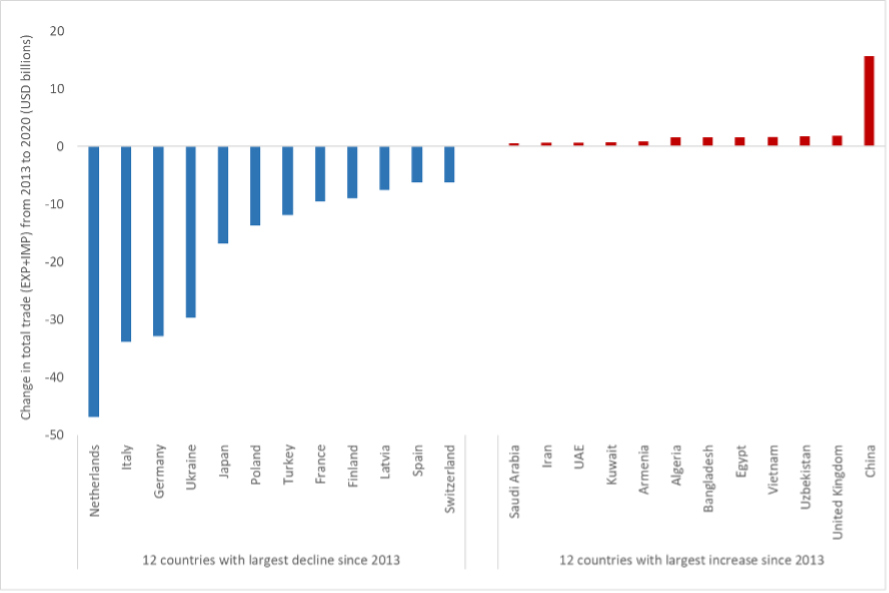
Source: IMF Direction of Trade Statistics, data until 2020. From Lehne (2022).
In response to Russia’s invasion of Ukraine in February 2024, Western governments imposed strict trade and financial sanctions on Russian businesses and individuals involved in the war (see S&P Global, 2024). These sanctions are designed to hamper Russia’s war effort by reducing its ability to fight and finance the war. The sanctions make it illegal for, e.g., European companies to sell certain products to Russia as well as to import select Russian goods (Council of the European Union, 2024). Even though sanctions do not cover all trade with Russia, many foreign businesses have been pressured to pull out of Russia in an act of solidarity. The decision by these businesses to leave is voluntary and could reflect their concerns over possible consumer backlash. It is not uncommon for consumers to put pressure on businesses in times of geopolitical conflict. For instance, Pandya and Venkatesan (2016) find that U.S. consumers were less likely to buy French-sounding products when the relationship between both countries deteriorated.
The LeaveRussia Project
The LeaveRussia project, from the Kyiv School of Economics Institute (KSE Institute), systematically tracks foreign companies’ responses to the Russian invasion. The database covers a selection of companies that have either made statements regarding their operations in Russia, and/or are a large global player (“major companies and world-famous brands”), and/or have been mentioned in relation to leaving/waiting/withdrawing from Russia in major media outlets such as Reuters, Bloomberg, Financial times etc. (LeaveRussia, 2024). As of April 5th, 2024, the list contains 3342 firms, the companies’ decision to leave, exit or remain in the Russian market, the date of their announced action, and company details such as revenue, industry etc. The following chart uses publicly available data from the LeaveRussia project to illustrate patterns in business withdrawals from Russia following the invasion of Ukraine.
Figure 2a shows the number of foreign companies in Russia in the LeaveRussia dataset by their country of headquarters. Figure 2b shows the share of these companies that have announced a withdrawal from Russia by April 2024, by their country of headquarters.
Figure 2a. Total number of companies by country.
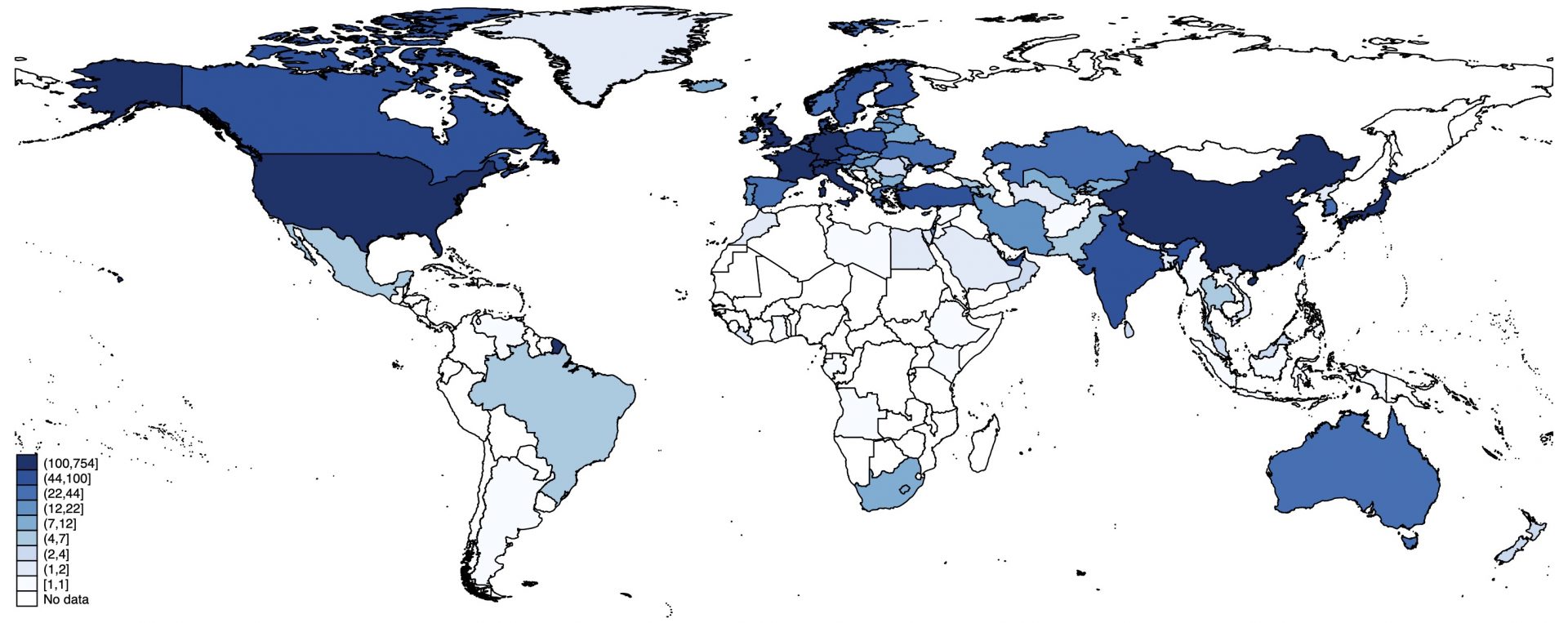
Figure 2b. Share of withdrawals, by country.
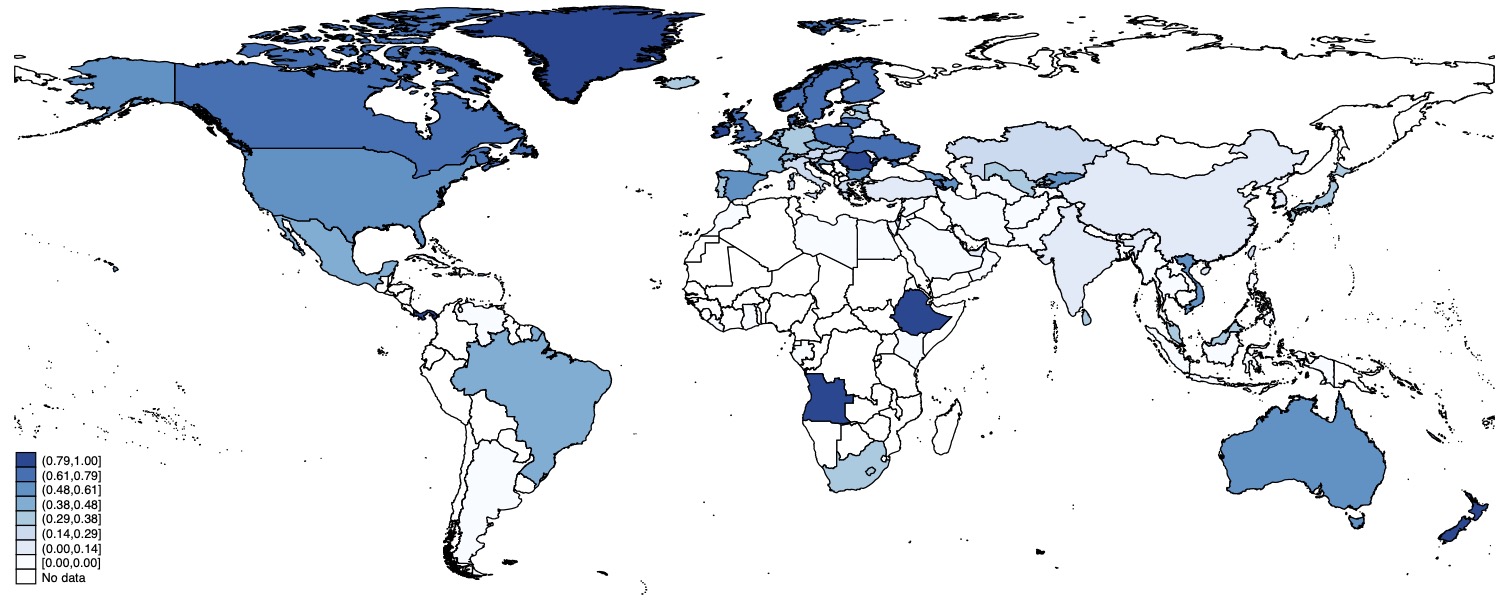
Source: Authors’ compilation based on data from the LeaveRussia project and global administrative zone boundaries from Runfola et al. (2020).
Some countries (e.g. Canada, the US and the UK) that had a large presence in Russia prior to the war have also seen a large number of withdrawals following the invasion. Other European countries, however, have seen only a modest share of withdrawals (for instance, Italy, Austria, the Netherlands and Slovakia). Companies headquartered in countries that have not imposed any sanctions on Russia following the invasion, such as Belarus, China, India, Iran etc., show no signs of withdrawing from the Russian market. In fact, the share of companies considered by the KSE to be “digging in” (i.e., companies that either declared they’d remain in Russia or who did not announce a withdrawal or downscaling as of 31st of March 2024) is 75 percent for more than 25 countries, including not only the aforementioned, but also countries such as Argentina, Moldova, Serbia and Turkey.
Withdrawal Determinants
The decision for companies to exit the market may range from consumer pressure to act in solidarity with Ukraine, to companies’ perceived risk from operating on the Russian market (Kiesel and Kolaric, 2023). Out of the 3342 companies in the LeaveRussia project’s database, about 42 percent have, as of April 5th, 2024, exited or stated an intention to exit the Russian market. This number increases only slightly to 49 percent when considering only companies headquartered in democratic (an Economist Intelligence Unit Democracy Index score of 7 or higher) countries within the EU. Figure 3 shows the number of companies that announced their exit from the Russian market, by month. A clear majority of companies announce their withdrawal in the first 6 months following the invasion.
Figure 3. Number of foreign companies announcing an exit from the Russian market, 2022-2024.

Source: Authors’ compilation based on data from the LeaveRussia project.
Similarly to the location of companies’ headquarters, the decision to exit the Russian market varies by industry. Figure 4 a depicts the top 15 industries with the highest share of announced withdrawals from the Russian market among industries with at least 10 companies. Most companies with high levels of withdrawals are found in consumer-sensitive industries such as the entertainment sector, tourism and hospitality, advertising etc.
Figure 4a. Top 15 industries in terms of withdrawal shares.
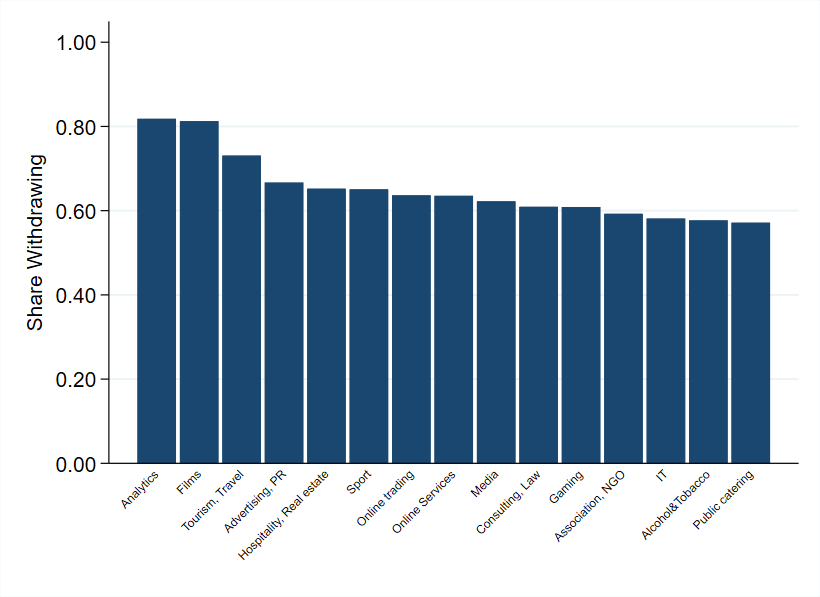
Figure 4b. Bottom 15 industries in terms of withdrawal shares.

Source: Authors’ compilation based on data from the LeaveRussia project.
In contrast, Figure 4b details the industries with the lowest share of companies opting to withdraw from the Russian market. Only around 10 percent of firms in the “Defense” and “Marine Transportation” industries chose to withdraw. Two-thirds of firms within the “Energy, oil and gas” and “Metals and Mining” sectors have chosen to remain in business in Russia following the war in Ukraine.
Several sectors have been identified as crucial in supplying the Russian military with necessary components to sustain their military aggression against Ukraine, mainly electronics, communications, automotives and related categories. We find that many of these sectors are among those with the lowest share of companies withdrawing from Russia. Companies for which Russia constitute a large market share have more to lose from exiting than others. Another reason for not exiting the market relates to the current legal hurdles of corporate withdrawal from Russia (Doherty, 2023). Others may simply not have made public announcements or operate within an industry dominated by smaller companies that are not on the radar of the LeaveRussia project. Nonetheless, Bilousova et al. (2024) detail that products from companies within the sanction’s coalition continue to be found in Russian military equipment destroyed in Ukraine. This is due to insufficient due diligence by companies as well as loopholes in the sanctions regime such as re-exporting via neighboring countries, tampering with declaration forms or challenges in jurisdictional enforcement due to lengthy supply chains, among others. (Olofsgård and Smitt Meyer, 2023).
And Those Who Didn’t Leave After All
The data from the LeaveRussia project details if and when foreign businesses announce that they will leave Russia. However, products from companies that have announced a departure from the Russian market continue to be found in the country, including in military components (Bilousova, 2024). In autumn 2023, investigative journalists from the Swedish newspaper Dagens Nyheter exposed 14 Swedish companies whose goods were found entering Russia, in most cases contrary to the companies’ public claims (Dagens Nyheter, 2023; Tidningen Näringslivet, 2023). For this series of articles, the journalists used data from Russian customs and verified it with information from numerous Swedish companies, covering the time period up until December 2022. This entailed reviewing thousands of export records from Swedish companies either directly to Russia or via neighboring countries such as Armenia, Kazakhstan, and Uzbekistan. All transactions mentioned in the article series have been confirmed with the respective companies, who were also contacted by DN prior to publication (Dagens Nyheter, 2023b). DNs journalists also acted as businessmen, interacting with intermediaries in Kazakhstan and Uzbekistan, exposing re-routing of Swedish goods from a company stated to have cut all exports to Russia in the wake of the invasion (Dagens Nyheter, 2023d).
For Sweden headquartered companies exposed in DN and that are traded on the Swedish Stock Exchange, we collect their stock prices and trading volume. Our data includes information on each stock’s average price, turnover, number of trades by date from around the date of the DN publications as well as the date of each company’s prior public announcement of exiting Russia. Table 1 details the companies who were exposed of doing direct or indirect business with Russia by DN and who had announced an exit from the Russian market previously. In their article series, DN also shows that goods from the following companies entered Russia; AriVislanda, Assa Abloy, Atlas Copco, Getinge, Scania, Securitas Tetra Pak, and Väderstad. Most of the companies exposed by DN operate within industries displaying low withdrawal shares.
Table 1. Select Swedish companies’, time of exit announcement and exposure in Dagens Nyheter and stock names.

Source: The LeaveRussia project, 2023; Dagens Nyheter, 2023b, 2023c, 2023d. Note: The exit statements have been verified through companies’ press statements and/or reports when available. For Epiroc, the claim has been verified via a previous Dagens Nyheter article (Dagens Nyheter, 2023a).
In Figure 5, we show the average stock price and trades-weighted average stock price of the Swedish companies in Table 1 around the time when the companies announced that they are leaving Russia.
Figure 5. Average stock price of companies in Table 1 around Russian exit announcements.
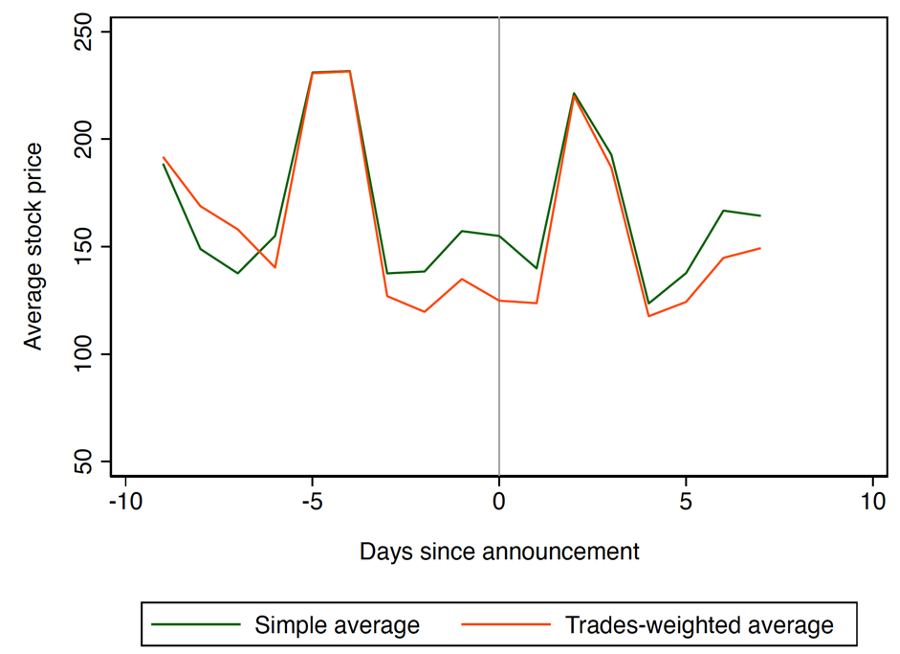
Source: Author’s compilation based on data from Nasdaq Nordic.
There appears to be an immediate increase in stock prices after firms announced their exit from the Russian market. Stock prices, however, reverse their gains over the next couple of days. In general, stock prices are volatile, and we also see similar-sized movements immediately before the announcement. Due to this volatility and the fact that we cannot rule out other shocks impacting these stock prices at the same time, it is difficult to attribute any movements in the stock prices to the firms’ decisions to leave Russia.
The academic evidence on investors’ reactions to firms divesting from Russia is mixed. Using a sample of less than 300 high-profile firms with operations in Russia compiled by researchers at the Yale Chief Executive Leadership Institute, Glambosky and Peterburgsky (2022) find that firms that divest within 10 days after the invasion experience negative returns, but then recover within a two-week period. Companies announcing divesting at a later stage do not experience initial stock price declines. In contrast, Kiesel and Kolaric (2023) use data from the LeaveRussia project to find positive stock price returns to firms’ announcements of leaving Russia, while there appears to be no significant investor reaction to firms’ decisions to stay in Russia.
When considering the effect from DN’s publications, the picture is almost mirrored, with the simple and trades-weighted average stock prices dipping in the days following the negative media exposure before not only recovering, but actually increasing. Similar caveats apply to the interpretation of this chart. In addition, the DN publication occurred shortly after the Hamas attacks on Israel on October 7 and Israel’s subsequent war on Gaza. While conflict and uncertainty typically dampen the stock market, the events in the Middle East initially caused little reaction on the stock market (Sharma, 2023).
Figure 6. Average stock price for companies listed in Table 1 around the time of DN exposure.

Source: Author’s compilation based on data from Nasdaq Nordic.
Discussion
As discussed in Becker et al. (2024), creating incentives and ensuring companies follow suit with the current sanctions’ regime should be a priority if we want to end Russia’s war on Ukraine and undermine its wider geopolitical ambitions. Nevertheless, Bilousova et al. (2024), and Olofsgård and Smitt Meyer (2023), highlight that there is ample evidence of sanctions evasions, including for products that are directly contributing to Russia’s military capacity. Even in countries that have a strong political commitment to the sanctions’ regime, enforcement is weak. For instance, in Sweden, it is not illegal to try and evade sanctions according to the Swedish Chamber of Commerce (2024). There is little coordination between the numerous law enforcement agencies that are responsible for sanction enforcement and there have been very few investigations into sanctions violations.
Absent effective sanctions enforcement and for the many industries not covered by sanctions, can we rely on businesses to put profits second and voluntarily withdraw from Russia? Immediately after the start of Russia’s invasion of Ukraine, as news stories about the brutality of the war proliferated, many international companies did announce that they will be leaving Russia. However, a more systematic look at data collected by the LeaveRussia project and KSE Institute reveals that more than two years into the war, less than half of companies based in Western democracies intend to distance themselves from the Russian market. A closer look at companies who are continuing operations in Russia reveals that they tend to be in sectors that are crucial for the Russian economy and war effort, such as energy, mining, electronics and industrial equipment. Many of these companies are probably seeing the war as a business opportunity and are reluctant to put human lives before their bottom line (Sonnenfeld and Tian, 2022).
Whether companies who announce that they are leaving Russia actually do leave is difficult to independently verify. A series of articles published in a prominent Swedish newspaper (Dagens Nyheter) last autumn revealed that goods from 14 major Swedish firms continue to be available in Russia, despite most of these firms publicly announcing their withdrawal from the country. The companies’ reactions to the exposé were mixed. A few companies, such as Scania and SSAB, have decided to cut all exports to the intermediaries exposed by the undercover journalists (for instance, in Kazakhstan, Uzbekistan and Kyrgyzstan). Other companies stated that they are currently investigating DN’s claims or that the exports exposed in the DN articles were final or delayed orders that were accepted before the company decided to withdraw from Russia. Another company, Trelleborg – a leading company within polymer solutions for a variety of industry purposes – reacted to the DN exposure by backtracking from its earlier commitment to exit the Russian market (Dagens Nyheter 2023b, 2023d). Wider reaction to these revelations was muted. Looking at changes in stock prices for the exposed companies, we find little evidence that investors are punishing companies for not honoring their public commitment to withdraw from Russia.
In an environment, where businesses themselves withdraw at low rates and investors do not shy away from companies contradicting their own claims, the need for stronger enforcement of sanctions seems more pressing than ever.
References
- Becker, T., Fredheim, K., Gars, J., Hilgenstock, B., Katinas, P., Le Coq, C., Mylovanov, T., Olofsgård, A., Perrotta Berlin, M., Pavytska, Y., Ribakova, E., Shapoval, N., Spiro, D. and Wachtmeister, H. (2024). Sanctions on Russia: Getting the Facts Right. FREE Policy Brief. https://freepolicybriefs.org/2024/03/14/sanctions-russia-war-ukraine/
- Bilousova, O., Hilgenstock, B., Ribakova, E., Shapoval, N., Vlasyuk, A. and Vlasiuk, V. (2024). CHALLENGES OF EXPORT CONTROLS ENFORCEMENT HOW RUSSIA CONTINUES TO IMPORT COMPONENTS FOR ITS MILITARY PRODUCTION. Yermak-McFaul International Working Group on Russian Sanctions & KSE Institute. https://kse.ua/wp-content/uploads/2024/01/Challenges-of-Export-Controls-Enforcement.pdf
- Council of the European Union. (2023). Sanctions against Russia explained. European Council. https://www.consilium.europa.eu/en/policies/sanctions-against-russia/sanctions-against-russia-explained/#services
- Dagens Nyheter. (2023a). DN avslöjar: Wallenbergs gruvjätte gjorde affärer med ryskgrundat bolag – efter krigsutbrottet.
- Dagens Nyheter. (2023b). DN avslöjar: Svenska storbolagen i affärer med Rvssland – trots löftena.
- Dagens Nyheter. (2023c). Svenska miljardbolaget svek löftet – sålde till ryska hamnprojekt.
- Dagens Nyheter (2023d). Mellanhanden avslöjar: Så levereras stålet från SSAB till Ryssland.
- Doherty, B. (2023). Business in Russia: Why some firms haven’t left. BBC. https://www.bbc.com/worklife/article/20230918-business-in-russia-why-some-firms-havent-left
- Glambosky, M. and Peterburgsky, S. (2022). Corporate activism during the 2022 Russian invasion of Ukraine, Economics Letters, 217, 110650. https://doi.org/10.1016/j.econlet.2022.110650
- Kiesel, F. and Kolaric, S. (2023) Should I stay or should I go? Stock market reactions to companies’ decisions in the wake of the Russia-Ukraine conflict. Journal of International Financial Markets, Institutions and Money, Forthcoming. http://dx.doi.org/10.2139/ssrn.4088159
- LeaveRussia Project. (2024). https://leave-russia.org/our-methodology
- Lehne, J. (2022). https://www.youtube.com/watch?v=I1EFcZdj2Gw
- Olofsgård, A. and Smitt Meyer, C. (2024) How to Undermine Russia’s War Capacity: Insights from Development Day 2023. FREE Policy Brief. https://freepolicybriefs.org/2024/01/15/undermine-russias-war-capacity/
- Pandya, S. S., and Venkatesan, R. (2016) French roast: consumer response to international conflict—evidence from supermarket scanner data. Review of Economics and Statistics, 98(1), 42-56.
- Runfola, D., Rogers, L., Habib, J., Horn, S., Murphy, S., Miller, D., Day, H., Troup, L., Fornatora, D., Spage, N., Pupkiewicz, K., Roth, M., Rivera, C., Altman, C., Schruer, I., McLaughlin, T., Biddle, R., Ritchey, R., Topness, E., Turner, J., Updike, S., Buckman, H., Simpson, N., Lin, J., Anderson, A., Baier, H., Crittenden, M., Dowker, E., Fuhrig, S., Goodman, S., Grimsley, G., Layko, R., Melville, G., Mulder, M., Oberman, R., Panganiban, J., Peck, A., Seitz, L., Shea, S., Slevin, H., Yougerman, R. and Hobbs, L. (2020). geoBoundaries: A global database of political administrative boundaries. Plos One, 15(4), e0231866.
- Schwarzenberg. A. (2023). Russia’s Trade and Investment Role in the Global Economy. Congressional Research Services, Report IF12066. https://crsreports.congress.gov/product/pdf/IF/IF12066
- Sharma, R. (2023). Why markets are relatively calm in the geopolitical storm. Financial Times. https://www.ft.com/content/d194a8a2-60c1-4afe-83bf-44e529e16d40
- Sonnenfeld, J. and Tian, S. (2022). Some of the Biggest Companies Are Leaving Russia. Others Just Can’t Quit Putin. Here’s a List. The New York Times. https://www.nytimes.com/interactive/2022/04/07/opinion/companies-ukraine-boycott.html
- Sonnenfeld, J., Tian, S., Sokolowski, F., Wyrebkowski, M., and Kasprowicz, M. (2022). Business Retreats and Sanctions Are Crippling the Russian Economy. http://dx.doi.org/10.2139/ssrn.4167193
- Stockholms Handelskammare. (2022). Regionala handelsmönster med Ryssland. https://www.mynewsdesk.com/se/stockholmshandelskammare/documents/siffror-se-ru-punkt-pdf-420259
- Swedish Chamber of Commerce. (2024). Förslag på åtgärder mot kringgående av sanktioner. https://www.kommerskollegium.se/globalassets/publikationer/rapporter/2024/forslag-pa-atgarder-mot-kringgaenden-av-sanktioner.pdf
- S&P Global. (2024). Sanctions against Russia – a timeline. https://www.spglobal.com/marketintelligence/en/news-insights/latest-news-headlines/sanctions-against-russia-8211-a-timeline-69602559
- Tidningen Näringslivet (2023). Svensk export till Rysslands grannar rusar. https://www.tn.se/naringsliv/30641/svensk-export-till-rysslands-grannar-rusar/
Disclaimer: Opinions expressed in policy briefs and other publications are those of the authors; they do not necessarily reflect those of the FREE Network and its research institutes.
Would Electing More Women Make the U.S. Congress Less Polarized?

With growing ideological polarization in the electorate and among U.S. Congress members, the view that electing more women would help solve partisan gridlocks has also grown especially popular. In this policy brief we review recent evidence on gender differences in cooperative behavior among legislators and argue that the prediction that a more female U.S. Congress would be less polarized does not find strong support in the data. While, in the past, Republican women have cooperated more with Democrats than their male colleagues we find evidence that this was due to higher ideological proximity between Republican women and Democrats rather than gender per se. Among Democrats, women actually appear to cooperate less with the opposite party than their male colleagues. Moreover, in recent years gender differences in ideology among Republicans have been narrowing, which also reduce gender differences in cooperation with the opposite party.
Gender Differences in Cooperative Behavior
Observers of U.S. politics have repeatedly reported increasing polarization in the U.S. electorate and Congress over the last decade, with growing concerns that the partisan gridlocks that have impaired Congress’ activities in the last two years will only grow after the 2024 elections. At the same time, it is widely believed that electing more women to the U.S. Congress would help reduce partisanship among legislators and promote cooperation across party lines. For instance, a report by the Center for American Women and Politics found that “collaboration by women across party lines is often fostered by participation in bipartisan, single-sex activities […] which can lead to policy collaboration” (Dittmar et al. 2017). These beliefs are rooted not only in anecdotal evidence but also in academic studies that, through laboratory experiments, have shown that women tend to cooperate more than men (cooperation is considered as working in a team to achieve a common good). However, this finding is not universal across settings and studies (Balliet et al. 2011), which suggests some caution in foreseeing fewer partisan gridlocks when more women are elected. Moreover, while laboratory experiments are a very important tool to discover patterns of human behavior in “ideal” conditions, testing for the robustness of experimental findings in real-world settings is a necessary step to draw definite implications for society-level outcomes.
What then is the research-based evidence on women’s willingness to cooperate with opposite parties as legislators?
Do Women in the U.S. Congress Cooperate More With the Opposite Party Than Men?
The proportion of women in Congress continues to be low, currently standing at 29 percent of the House of Representatives and 25 percent of the Senate. However, women’s representation has massively increased over time, especially since the 101st Congress, which was elected in 1989 (see Figure 1). This change has prompted researchers to investigate the effects of women’s different approaches to competitive and cooperative situations on the day-to-day working of Congress.
In examining the dynamics of legislative cooperation, contrasting viewpoints shed light on the role of gender in policymaking. Volden et al. (2013) find that women’s increased cooperativeness especially helps female lawmakers from minority parties who are able to sustain their bills throughout the legislative process, while more obstructive Congress members fail to find consensus. Offering an alternative explanation, Anzia and Berry (2011) show that female lawmakers indeed sponsor and co-sponsor more bills than male lawmakers but argue that this is due to only the best and most ambitious women entering Congress due to discrimination.
Figure 1. Women in Congress over time.
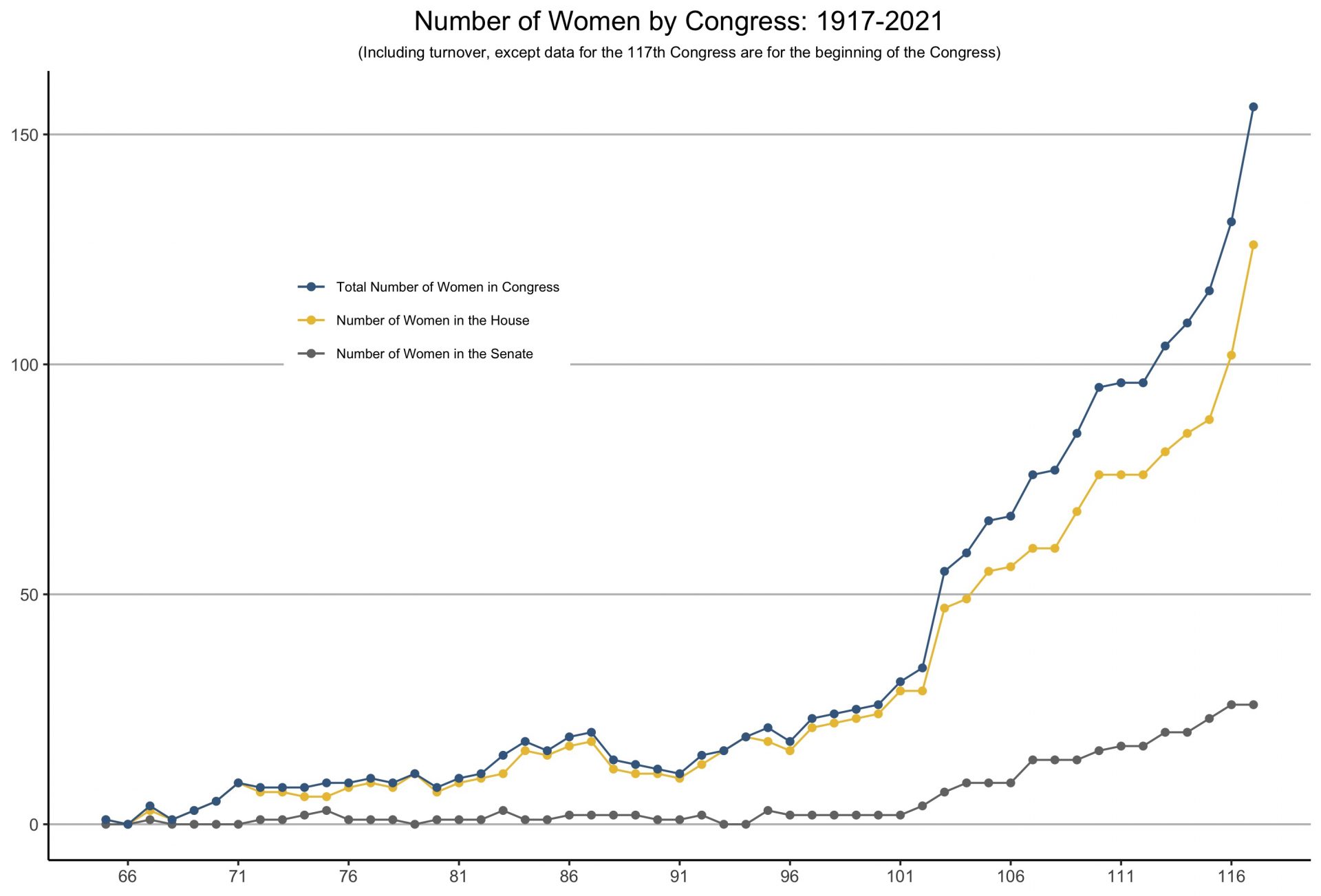
Source: Bagues et al. (2023), data from the Congressional Research Service.
This early work highlights the importance of studying gender differences in Congress overall and by party, while comparing women and men who have similar characteristics and are elected in comparable districts.
In a recent study, Gagliarducci and Paserman (2022) adopt several empirical strategies to assess the extent to which largely comparable women and men in Congress behave differently in terms of cooperativeness. Their measure of cooperation is the number of co-sponsors that women and men respectively attract on their bills, and what share of these co-sponsors that are from the opposite party. Each bill presented to the U.S. Congress has a main sponsor and can have an unlimited number of co-sponsors. These co-sponsors attract support for the bill and aid its passage through the necessary legislative steps. Gagliarducci and Paserman (2022) consider bills proposed to the U.S. Congress between 1988 and 2010 and find that among Democrats there is no significant gender gap in the number of co-sponsors recruited, but women-sponsored bills tend to have fewer co-sponsors from the opposite party. On the other hand, they establish robust evidence that Republican women recruit more co-sponsors and attract more bipartisan support on their bills than Republican men. They conclude that this pattern indicates that cooperation is mostly driven by a commonality of interest, rather than gender per se. This since during this period female Republican representatives were ideologically closer to Democrats than their male colleagues, whereas Democratic women were ideologically further away from Republicans. They proxy representatives’ ideology using information on the ideological leaning of voters in representatives’ constituency in the presidential elections. As the authors observe, these findings challenge the commonly held view that an increase in female representation in the US Congress would help solve partisan gridlock.
In a recent working paper (Bagues et al. 2023), we assess the replicability and reproducibility of these findings, given their practical relevance in the face of the upcoming 2024 Congress elections. Our work is part of a large effort promoted by the Institute for Replication to improve the credibility of social science by systematically reproducing and replicating research findings published in leading academic journals.
Using the same data and empirical strategies as in Gagliarducci and Paserman (2022), except for correcting for some data collection errors and proposing different assumptions on the empirical specifications, we virtually confirm all their original findings. Most importantly, we also extend the analysis to cover 2011-2020 to study gender differences in legislative cooperation in a context that differs in at least two relevant aspects. During this period the share of women in the House of Representatives became substantially larger and, moreover, within-party gender differences in ideology changed compared to previous decades. While Democratic female representatives are still less conservative that Democratic men, women became ideologically more similar to their male colleagues among Republicans. We reach this conclusion by proxying representatives’ ideology using information on the ideological leaning of voters in representatives’ constituency in the presidential elections, as in Gagliarducci and Paserman (2022).
Consistent with the hypothesis that gender differences in cooperation across parties are driven mainly by ideological distance, we observe that bills sponsored by female Democrats are less likely to have opposite party co-sponsors than bills sponsored by male Democrats. We also, do not observe any gender differences in bipartisan cooperative behavior among Republicans. Finally, we observe more robust evidence that during the last decade bills from both Republican and Democratic women attracted more sponsors than bills from their male colleagues.
In sum, the novel evidence from the 2011-2020 period strengthens the finding that cooperation with members of the other party is driven mainly by ideological proximity rather than gender per se.
Conclusion
We have reviewed the recent academic literature on gender differences in willingness to cooperate among legislators, considering the largely popular view that a more female U.S. Congress would be less polarized and thus face fewer partisan gridlocks. Such a view is particularly salient at a time of increased polarization in U.S. politics and growing representation of women in the U.S. Congress.
Overall, studies of the extent to which bills promoted by women and men in Congress attract co-sponsors from members of the opposite party invite caution in predicting fewer gridlocks from the election of more women. Women legislators do not appear to be inherently more willing to cooperate with the opposite party. Gender differences in cooperation noticed in the past seem to be mainly driven by Republican women being more likely to legislate with Democrats because of a higher degree of ideological proximity to the opposite party compared to their male colleagues. However, analysis of recent data also show that Republican women have become ideologically more aligned to their male colleague in the last decade. This suggests that as the share of women in Congress increases, their characteristics and ideological standing might also change, making it hard to predict patterns of future behavior based on the past.
References
- Anzia, Sarah F., and Christopher R. Berry. (2011). The Jackie (and Jill) Robinson effect: Why do congresswomen outperform congressmen? American Journal of Political Science 55, no. 3. pp. 478-493.
- Bagues, Manuel, Pamela Campa, and Giulian Etingin-Frati. (2022). Gender Differences in Cooperation in the US Congress? An Extension of Gagliarducci and Paserman. No. 75. I4R Discussion Paper Series, 2023.
- Balliet, Daniel, Norman P. Li, Shane J. Macfarlan, and Mark Van Vugt. (2011). Sex differences in cooperation: a meta-analytic review of social dilemmas. Psychological Bulletin 137, no. 6. p. 881.
- Dittmar, Kelly, Sanbonmatsu, Kira, Carroll, Susan, Walsh, Debbie, and Wineinger, Catherine. (2017). Representation Matters: Women in the U.S. Congress. Centre for American Women and Politics, Rutgers University.
- Gagliarducci, Stefano, and M. Daniele Paserman. (2022). Gender differences in cooperative environments? Evidence from the US Congress. The Economic Journal 132, no. 641, pp. 218-257.
- Volden, Craig, Alan E. Wiseman, and Dana E. Wittmer. (2013). When are women more effective lawmakers than men?. American Journal of Political Science 57, no. 2. pp.326-341.
Disclaimer: Opinions expressed in policy briefs and other publications are those of the authors; they do not necessarily reflect those of the FREE Network and its research institutes.
Online Political Influence and Misinformation

On May 13 2024, the Forum for Research on Media and Democracy in Eastern Europe (FROMDEE) and the Stockholm Institute of Transition Economics (SITE) are organizing a conference in Stockholm on “Online Political Influence and Misinformation” with a keynote lecture by Jacob Shapiro (Princeton University).
Conference Brief
Online platforms, such as Facebook and X, have significantly impacted democratic processes. By enabling individuals to connect with millions of other users and potential voters, they have empowered citizen journalists and grassroots movements. However, these platforms have also dramatically accelerated the spread of misinformation and disinformation in society through fake news and conspiracy theories. Many online misinformation campaigns are conducted by foreign actors seeking to sow discord and undermine liberal democratic values. Our conference aims to bring together academics, policymakers, and civil society to highlight these online threats and discuss how our societies can effectively respond to them.
Keynote Speaker

Jacob Shapiro (Princeton University)
Professor Shapiro will be talking about Russian foreign influence campaigns in Western democracies. His lecture will be followed by two policy panels featuring policymakers, journalists, and academics:
- (i) Russian disinformation campaigns;
- (ii) Social media and media literacy.
Speakers
- Magnus Hjort (Director General of the Swedish Psychological Defence Agency)
- Yelyzaveta Chekhovska (Senior Analyst at VoxCheck, VoxUkraine)
- Sonja Buchegger (Professor of Computer Science at KTH)
- Zhenqi Liu (Assistant Professor at the Johns Hopkins Carey Business School)
- Inga Springe (Investigative journalist and co-founder of Re:Baltica)
- Michael Rochlitz (Associate Professor at the University of Oxford)
Registration and Program
The event will take place in the Aula, located in the main building of SSE and the registration opens at 13.30 outside the Aula. Please proceed with your registration via the Trippus platform by clicking the following link (see here). See the program in the following link (see here). Please contact site@hhs.se if you have any questions regarding the event.
Disclaimer: Opinions expressed during events and conferences are those of the authors; they do not necessarily reflect those of the FREE Network and its research institutes.
The conference is organised as part of the FREE Network Initiative Forum for Research on Media and Democracy in Eastern Europe (FROMDEE), supported by the Swedish International Development Cooperation Agency (Sida).
About FROMDEE
In 2021 the FREE Network initiated the Forum for Research on Media and Democracy in Eastern Europe (FROMDEE). The long-run goal of FROMDEE is to help strengthen media and democracy in the region and bring together researchers with experience doing empirical work on these topics while facilitating the exchange of data and contextual knowledge across the FREE network, as well as building capacity to work on the frontier of social and data science.
Navigating Environmental Policy Consistency Amidst Political Change

Europe, like other parts of the world, currently grapples with the dual challenges of environmental change and democratic backsliding. In a context marked by rising populism, misinformation, and political manipulation, designing credible sustainable climate policies is more important than ever. The 2024 annual Energy Talk, organized by the Stockholm Institute of Transition Economics (SITE), gathered experts to bring insight into these challenges and explore potential solutions for enhancing green politics.
In the last decades, the EU has taken significant steps to tackle climate change. Yet, there is much to be done to achieve climate neutrality by 2050. The rise of right-wing populists in countries like Italy and Slovakia, and economic priorities that overshadow environmental concerns, such as the pause of environmental regulations in France and reduced gasoline taxes in Sweden, are significantly threatening the green transition. The current political landscape, characterized by democratic backsliding and widespread misinformation, poses severe challenges for maintaining green policy continuity in the EU. The discussions at SITEs Energy Talk 2024 highlighted the need to incorporate resilience into policy design to effectively manage political fluctuations and ensure the sustainability and popular support of environmental policies. This policy brief summarizes the main points from the presentations and discussions.
Policy Sustainability
In his presentation, Michaël Aklin, Associate Professor of Economics and Chair of Policy & Sustainability at the Swiss Federal Institute of Technology in Lausanne, emphasized the need for environmental, economic, and social sustainability into climate policy frameworks. This is particularly important, and challenging given that key sectors of the economy are difficult to decarbonize, such as energy production, transportation, and manufacturing. Additionally, the energy demand in Europe is expected to increase drastically (mainly due to electrification), with supply simultaneously declining (in part due to nuclear power phaseout in several member states, such as Germany). Increasing storage capacity, enhancing demand flexibility, and developing transmission infrastructure all require large, long-term investments, and uncompromising public policy. However, these crucial efforts are at risk due to ongoing political uncertainty. Aklin argued that a politics-resilient climate policy design is essential to avoid market fragmentation, decrease cooperation, and ensure the support for green policies. Currently, industrial policy is seen as the silver bullet, in particular, because it can create economies of scale and ensure political commitment to major projects. However, as Aklin explained, it is not an invincible solution, as such projects may also be undermined by capacity constraints and labour shortages.
Energy Policy Dynamics
Building on Aklin’s insights, Thomas Tangerås, Associate Professor at the Research Institute of Industrial Economics, explored the evolution of Swedish energy policy. Tangerås focused on ongoing shifts in support for nuclear power and renewables, driven by changes in government coalitions. Driven by an ambition to ensure energy security, Sweden historically invested in both hydro and nuclear power stations. In the wake of the Three Mile Island accident, public opinion however shifted and following a referendum in 1980, a nuclear shutdown by 2010 was promised. In the new millennia, the first push for renewables in 2003, was followed by the right-wing government’s nuclear resurgence in 2010, allowing new reactors to replace old ones. In 2016 there was a second renewable push when the left-wing coalition set the goal of 100 percent renewable electricity by 2040 (although with no formal ban on nuclear). This target was however recently reformulated with the election of the right-wing coalition in 2022, which, supported by the far-right party, launched a nuclear renaissance. The revised objective is to achieve 100 percent fossil-free electricity by 2040, with nuclear power playing a crucial role in the clean energy mix.
The back-and-forth energy policy in Sweden has led to high uncertainty. A more consistent policy approach could increase stability and minimize investment risks in the energy sector. Three aspects should be considered to foster a stable and resilient investment climate while mitigating political risks, Tangerås concluded: First, a market-based support system should be established; second, investments must be legally protected, even in the event of policy changes; and third, financial and ownership arrangements must be in place to protect against political expropriation and to facilitate investments, for example, through contractual agreements for advance power sales.
The Path to Net-Zero: A Polish Perspective
Circling back to the need for climate policy to be socially sustainable, Paweł Wróbel, Energy and climate regulatory affairs professional, Founder of GateBrussels, and Managing Director of BalticWind.EU, gave an account of Poland’s recent steps towards the green transition.
Poland is currently on an ambitious path of reaching net-zero, with the new government promising to step up the effort, backing a 90 percent greenhouse gas reduction target for 2040 recently proposed by the EU However, the transition is framed by geopolitical tensions in the region and the subsequent energy security issues as well as high energy prices in the industrial sector. Poland’s green transition is further challenged by social issues given the large share of the population living in coal mining areas (one region, Silesia, accounts for 12 percent of the polish population alone). Still, by 2049, the coal mining is to be phased out and coal in the energy mix is to be phased out even by 2035/2040 – optimistic objectives set by the government in agreement with Polish trade unions.
In order to achieve this, and to facilitate its green transition, Poland has to make use of its large offshore wind potential. This is currently in an exploratory phase and is expected to generate 6 GW by 2030, with a support scheme in place for an addition 12 GW. In addition, progress has been achieved in the adoption of solar power, with prosumers driving the progress in this area. More generally, the private sectors’ share in the energy market is steadily increasing, furthering investments in green technology. However, further investments into storage capacity, transmission, and distribution are crucial as the majority of Polands’ green energy producing regions lie in the north while industries are mainly found in the south.
Paralleling the argument of Aklin, Wróbel also highlighted that Poland’s high industrialization (with about 6 percent of the EU’s industrial production) may slow down the green transition due to the challenges of greening the energy used by this sector. The latter also includes higher energy prices which undermines Poland’s competitiveness on the European market.
Conclusion
The SITE Energy Talk 2024 catalyzed discussions about developing lasting and impactful environmental policies in times of political and economic instability. It also raised questions about how to balance economic growth and climate targets. To achieve its 2050 climate neutrality goals, the EU must implement flexible and sustainable policies supported by strong regulatory and political frameworks – robust enough to withstand economic and political pressures. To ensure democratic processes, it is crucial to address the threat posed by centralised governments decisions, political lock-ins, and large projects (with potential subsequent backlashes). This requires the implementation of fair policies, clearly communicating the benefits of the green transition.
On behalf of the Stockholm Institute of Transition Economics, we would like to thank Michaël Aklin, Thomas Tangerås and Paweł Wróbel for participating in this year’s Energy Talk.
Disclaimer: Opinions expressed in policy briefs and other publications are those of the authors; they do not necessarily reflect those of the FREE Network and its research institutes.
